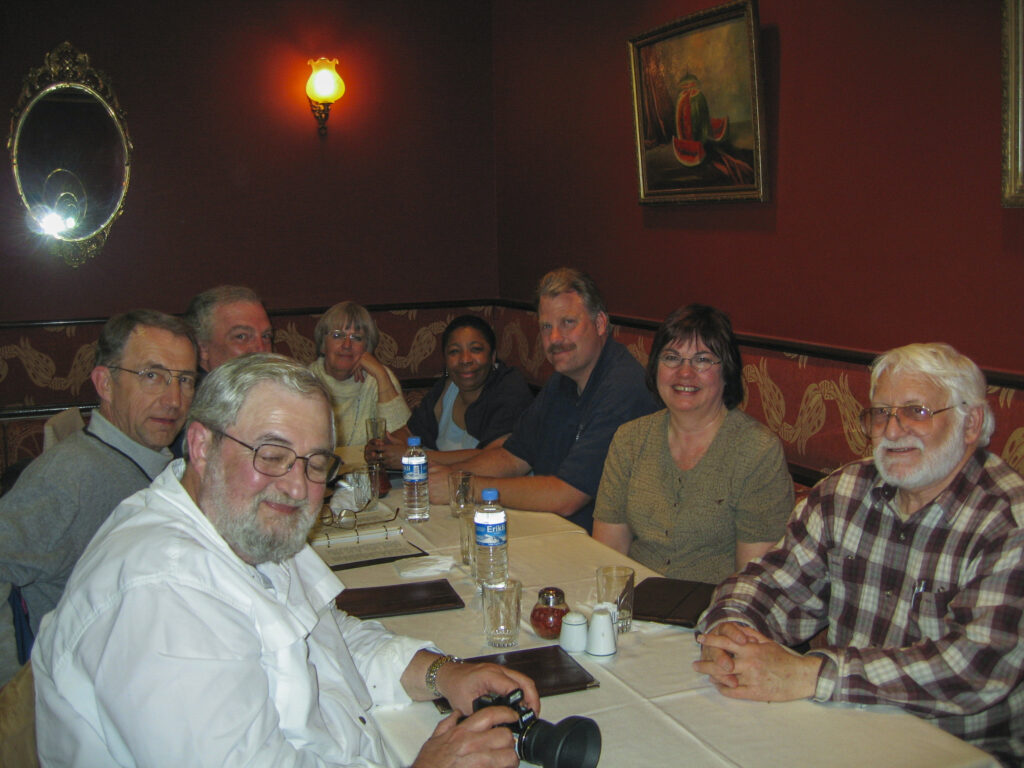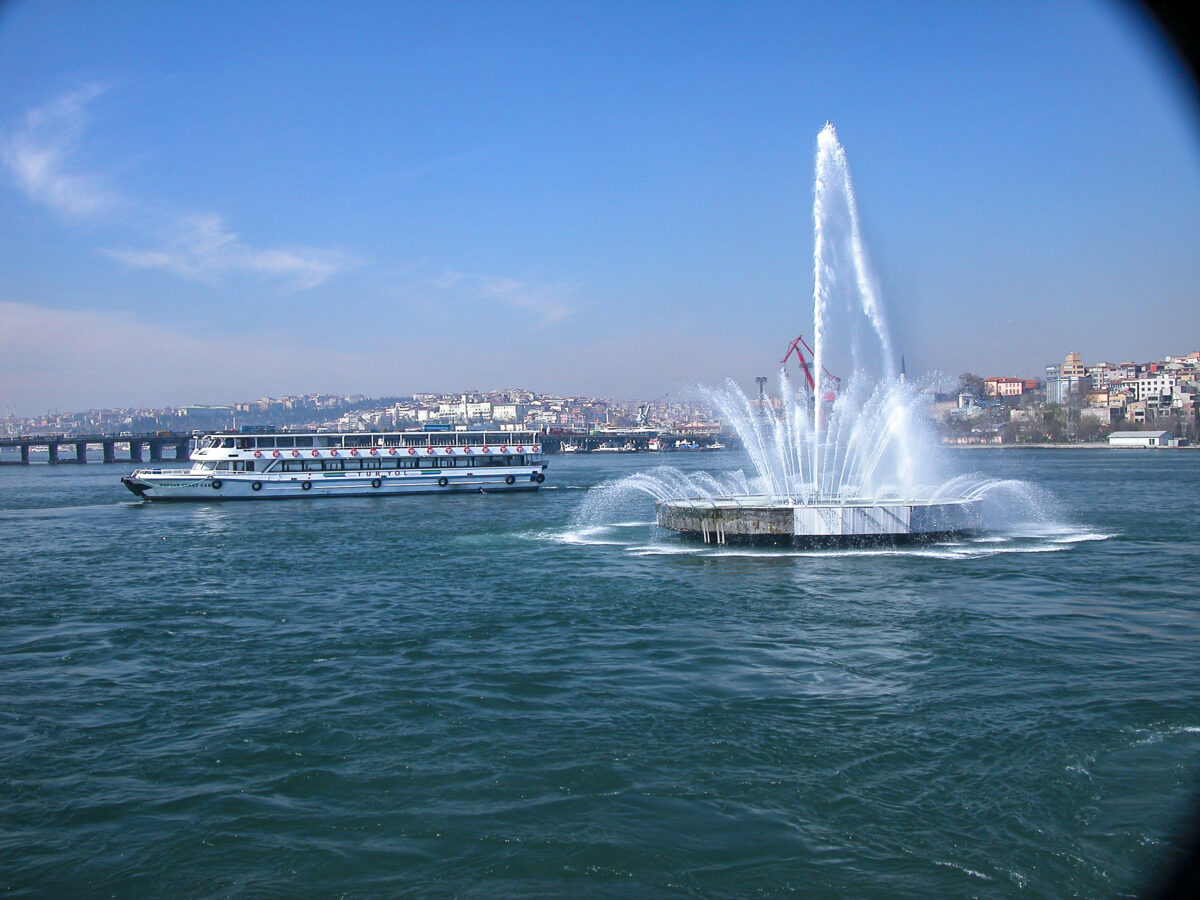The afternoon of March 30, 2006, was the occasion of a memorable odyssey on the waterways of Istanbul. We boarded our cruise boat at a dock in the Eminönü waterfront area, on the south side of the Golden Horn, near Galata Bridge in the shadow of the Suleiman Mosque.
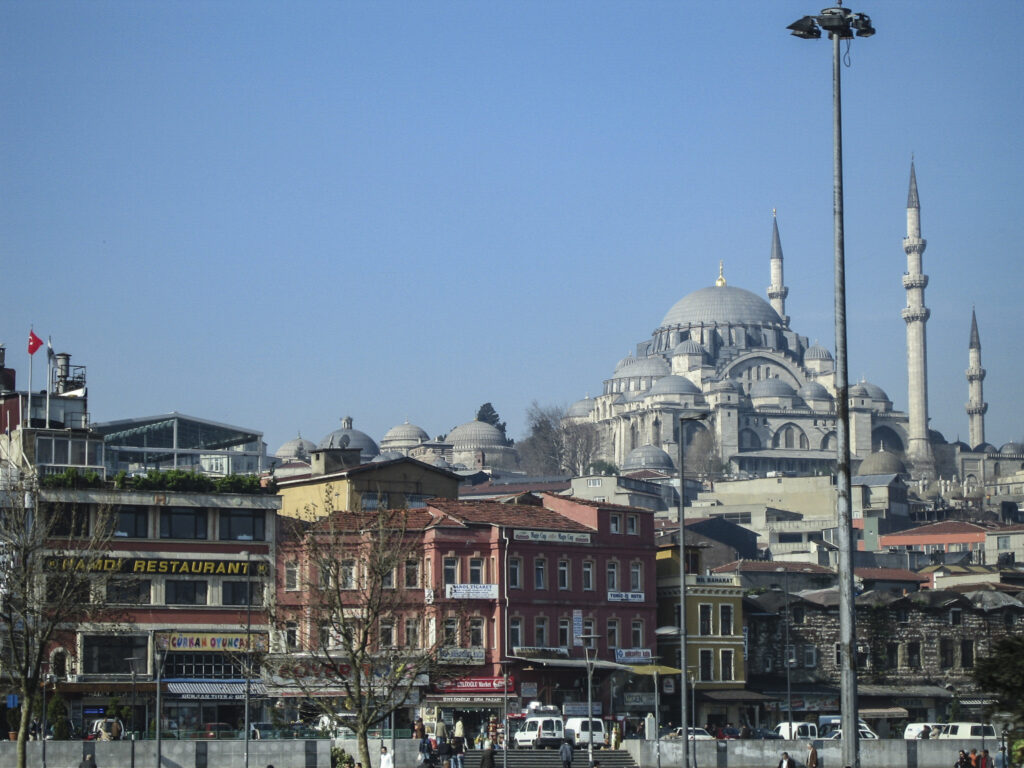
As our cruise boat pulled away from the dock, I snapped a photo of the opposite shore of the Golden Horn, focusing on the Galata Bridge. I was unaware of it at the time I shot this picture, but there is a lot of history behind this bridge. It is at least the fifth Galata Bridge over the Golden Horn. Before the first was built, there were many proposals and designs, one of them submitted by Leonardo da Vinci in response to a request by Sultan Bayezid II at the beginning of the 16th century. Leonardo’s proposal was rejected, and Michelangelo, who was also solicited, would have nothing to do with it. The first bridge was built in the 19th century. The current bridge is the fifth; it was completed in 1994 by a Turkish construction company, replacing a previous bridge built by a German contractor in 1912. (I always enjoy hearing that the locals can do the job and don’t need to rely on foreign firms to do the hard stuff.) This bridge has a particular appeal to me because fishermen are able to fish from it, apparently without official restrictions, and the lower level is lined with fish restaurants, indicating that these waters aren’t too polluted to fish from (or at least I hope so).
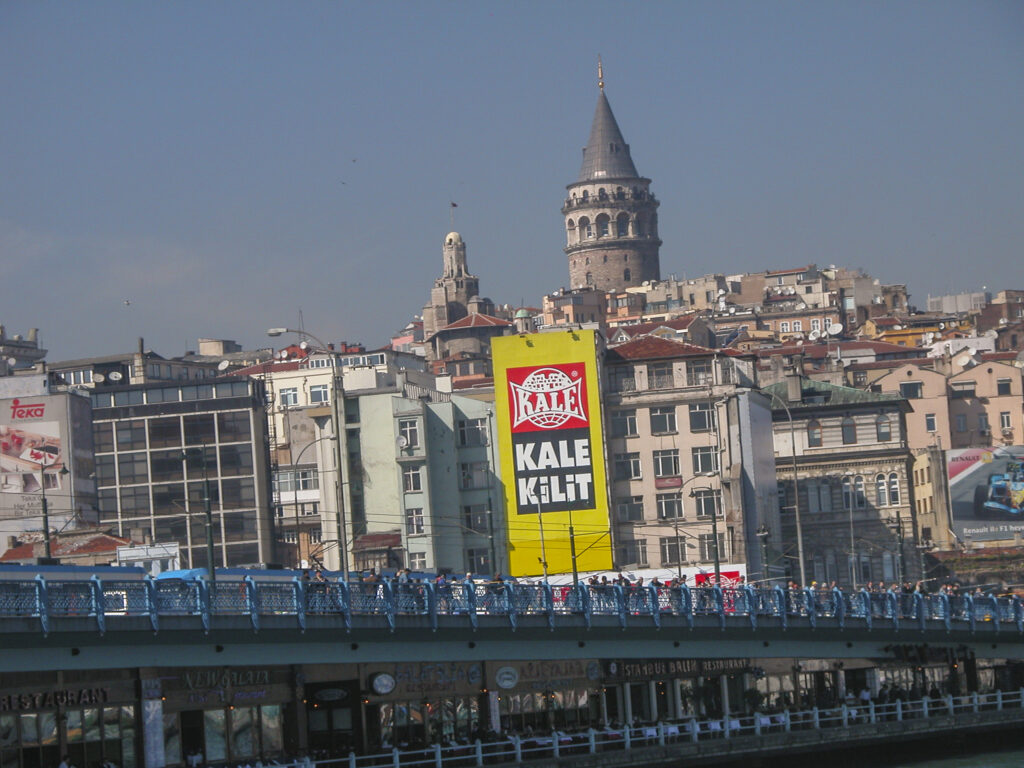
We shortly rounded Seraglio Point, the site of the Topkapı Palace, and got a great panoramic view of the area we had visited in the morning.
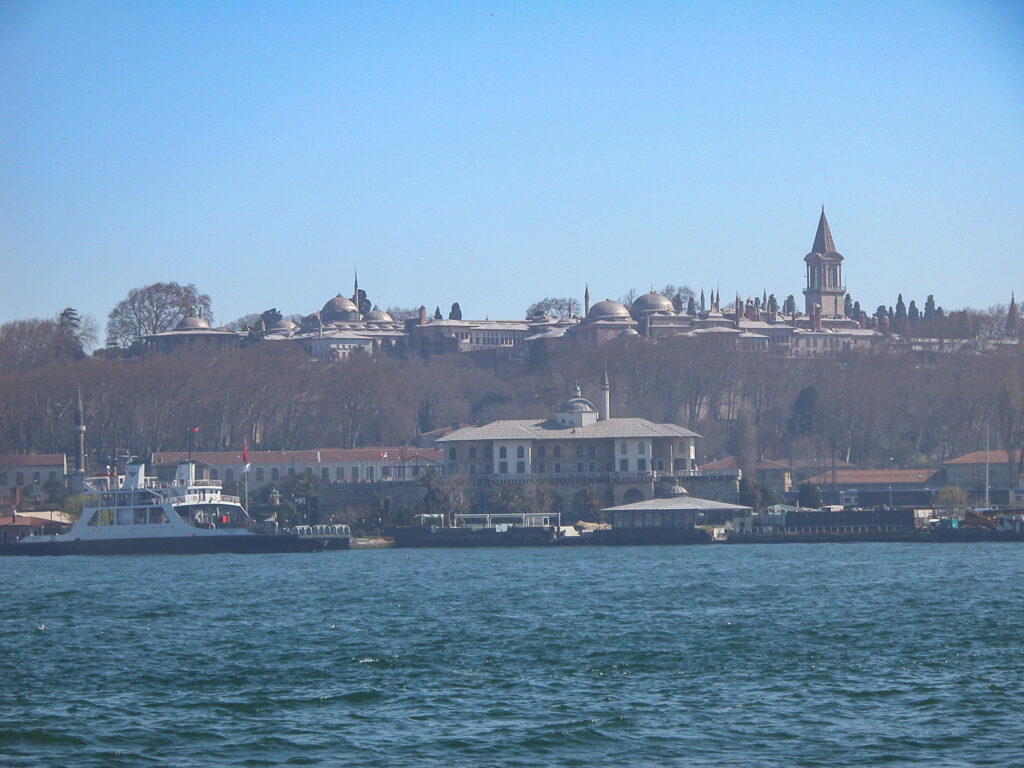
From the cruise boat we caught sight of a part of the Topkapı complex not visible to us during the morning’s visit. On the shoreline below the palace gardens, there used to be a row of pavilions and palaces belonging to the Topkapı palace, but now the only one remaining is the Basketweavers’ Pavilion (or Kiosk), the Sepetçiler Köşkü. It was built by Sultan Murad III in 1591 as a place for Roma basketweavers to sell their goods, but has undergone many changes of usage since then, and is now the headquarters of the Turkish Green Crescent, a nonprofit benevolent society dedicated to combating substance abuse.
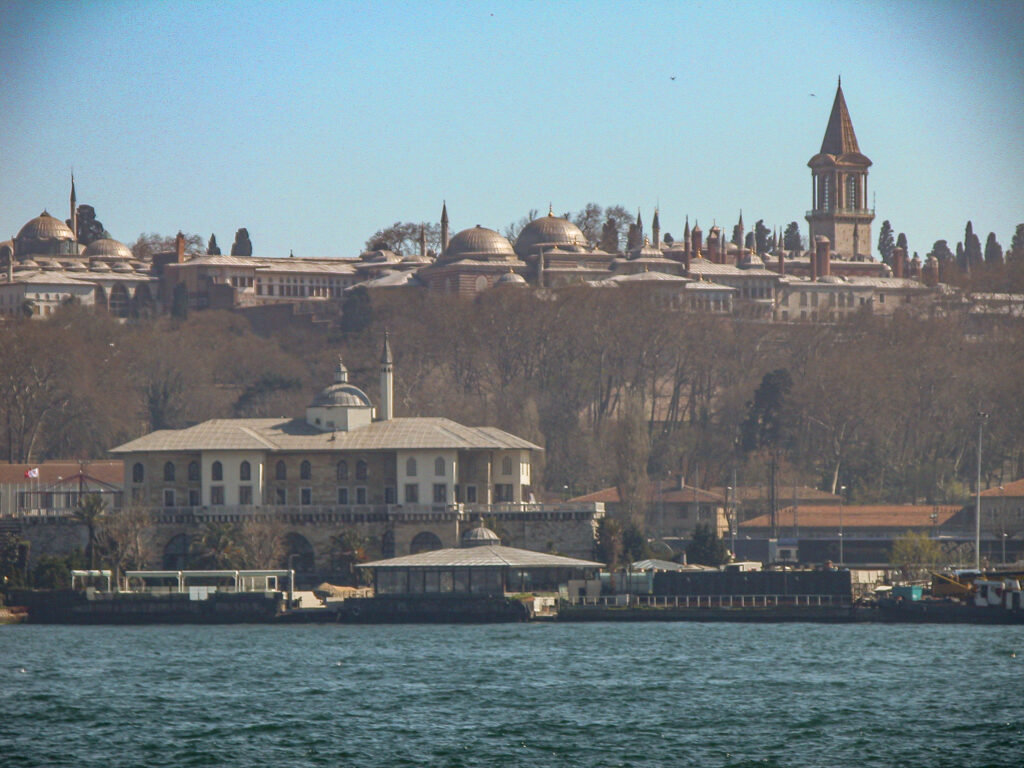
The cruise boat also provided a view of what used to be known as the Sublime Porte. I think I mentioned in a previous post that the Sultan’s ministers used to announce his decrees at the main gate of the palace, the Bâb-ı Hümâyûn, and this was translated into French (the French being the first of the Western European powers to conclude an alliance with the Ottoman Turks, in 1536) as “Sublime Porte.” The Europeans began to use this term to refer to the Ottoman government as a whole. When, in the 18th century, a grand new Italian-style building was built to house the Grand Vizier and his subordinates, it also had a magnificent ceremonial gate, the Bab-ı Ali, and that gate became the Sublime Porte. After the Ottoman Empire gave way to the Turkish Republic in the 1920s, the term Sublime Porte fell out of use, and the former headquarters of the Grand Vizier is now the seat of the Governor of Istanbul Province.
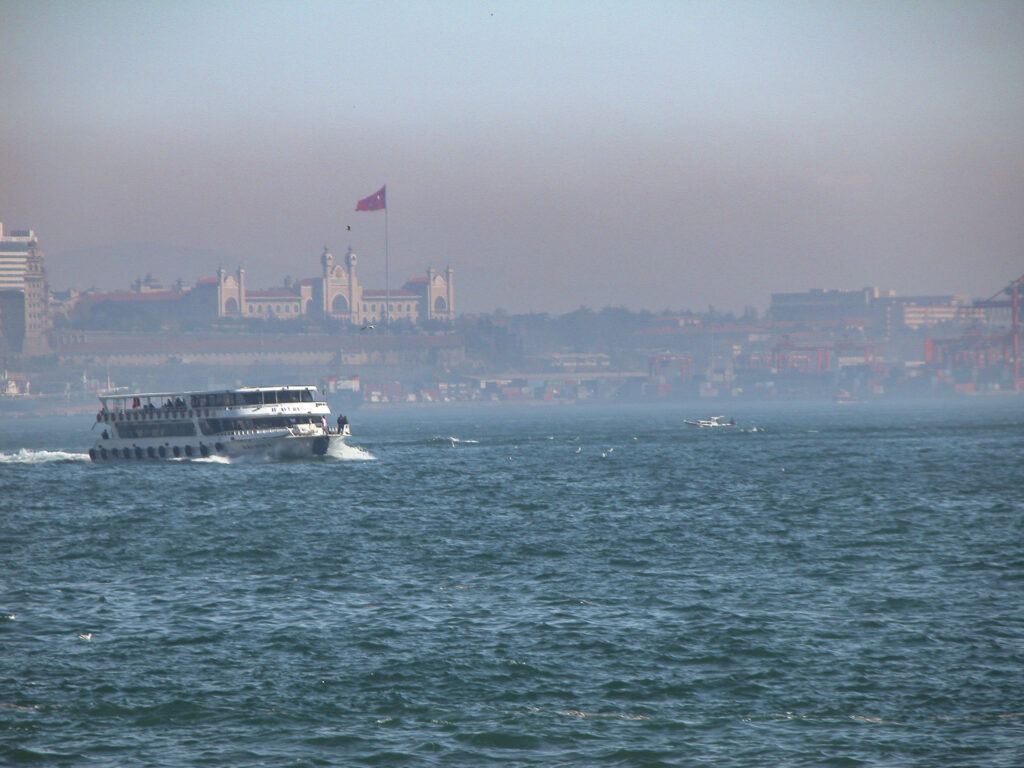
Istanbul’s location astride the Bosporus, the busiest and narrowest international navigation strait in the world, guarantees its importance as a seaport, and it was no surprise to see abundant evidence of the key role of seaborne commerce in the city’s economy. (In 2018, 74% percent of the city’s exports and 93% percent of its imports in 2018 went by sea; over 200 million tons of oil alone go through the Straits each year.) It was a bit of a surprise, though, to see a passenger balloon casually hovering over the port. We never found out for sure, but my guess was that some enterprising entrepreneur had established a business operating harbor cruises by balloon for daring and well-heeled tourists.
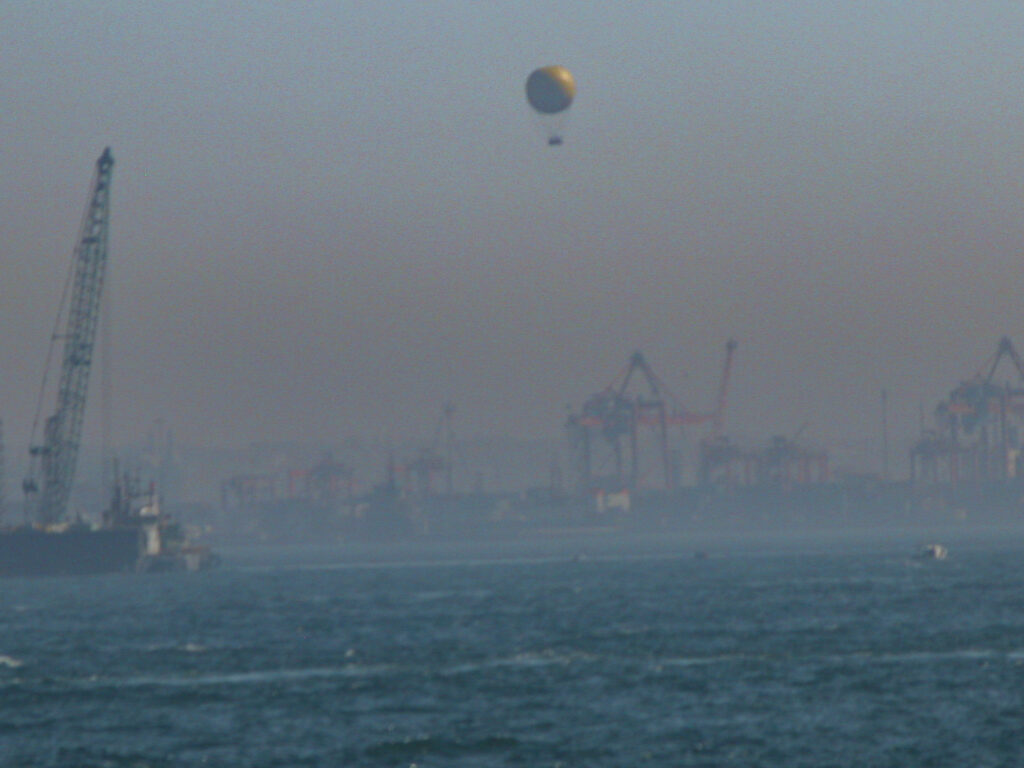
After the end of the Tulip Period, beginning around 1740, Ottoman architects began to more openly imitate European architectural styles, and the Turkish Rococo creations exemplified by the Fountain of Sultanahmet III gave way to a full-blown Ottoman Baroque style, which persisted through numerous variations and reincarnations down to the nineteenth century. The Dolmabahçe Mosque, seen below, was commissioned by the Valide Sultan, mother of Abdülmecid I, in 1855, with the design entrusted to an Armenian architect, Garabet Balyan. Its distinctive feature is the stone arches on all sides, into which are cut large windows admitting a flood of light into the interior.
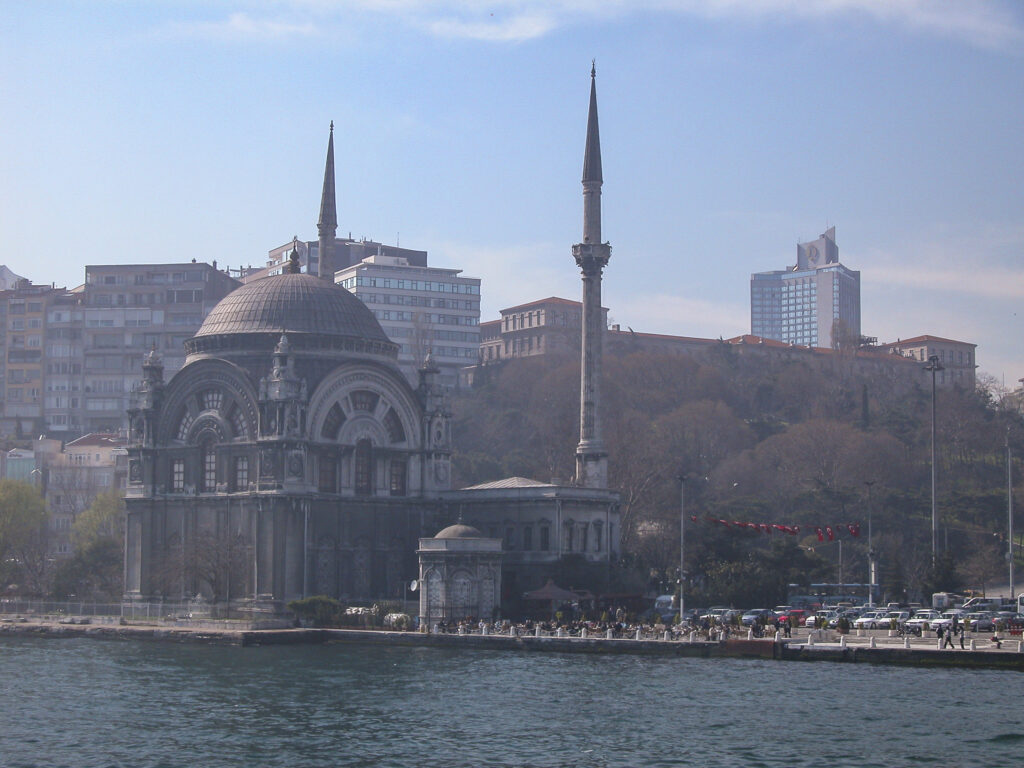
As you might guess, the Dolmabahçe Mosque is quite near the Dolmabahçe Palace, and indeed it shortly came into view. But first we encountered its clock tower, which was actually the last major structure added to the palace complex, in 1890-95, much later than the construction of the palace itself.
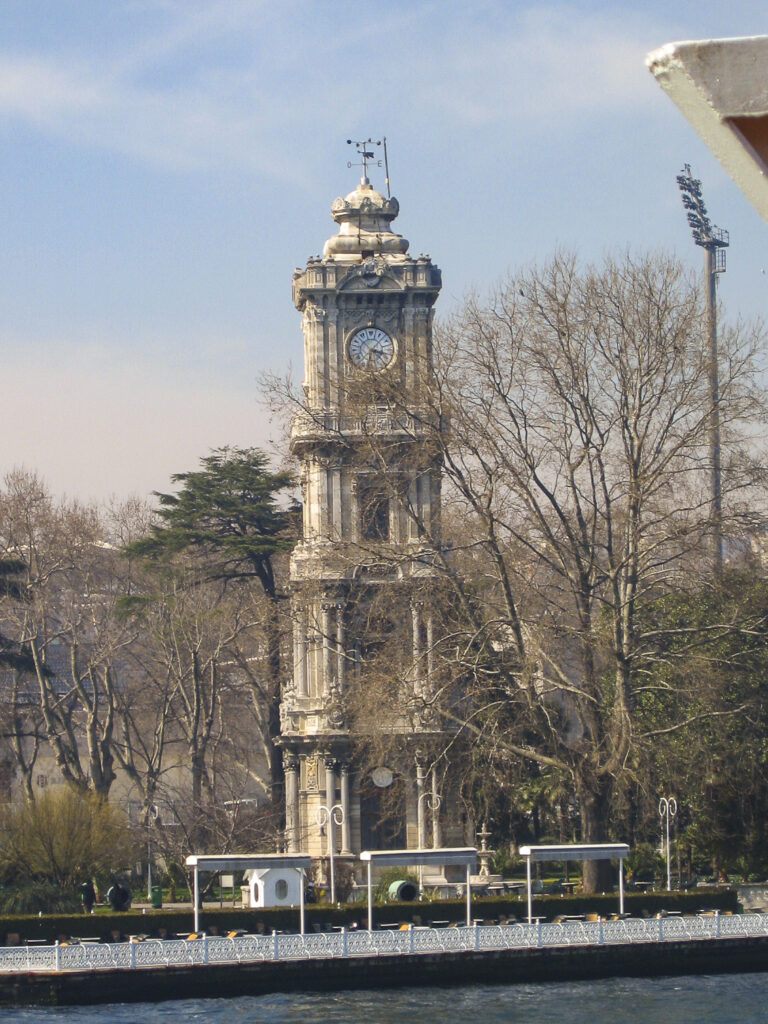
The Dolmabahçe Palace was commissioned by the reforming Sultan Abdülmecid I in 1843 and completed in 1856. The Ottomans had already built several palaces along the shores of the Bosporus – mostly as summer risidences – but the Dolmabahçe was specifically intended to replace the Topkapı as the primary residence of the Sultan. The reasons usually given are that the Topkapı was too “medieval,” outdated and lacking in the luxuries, comforts and accoutrements enjoyed by contemporary European monarchs. Given that we had just seen the Topkapı that morning, and it looked quite luxurious and comfortable to us, one wonders why the Sultan couldn’t have just followed the usual practice of adding a new structure to the palace if he didn’t like the existing ones? In fact he did do that, but apparently it wasn’t enough. I surmise that he not only wanted a showcase of the latest trends and styles to impress the Europeans, but also to sweep the Ottoman past, with its associations of backwardness and insularity, under the rug. One online source states flatly that the true reason for building the Dolmabahçe Palace was to hide the fact that the Ottoman Empire was in decline.
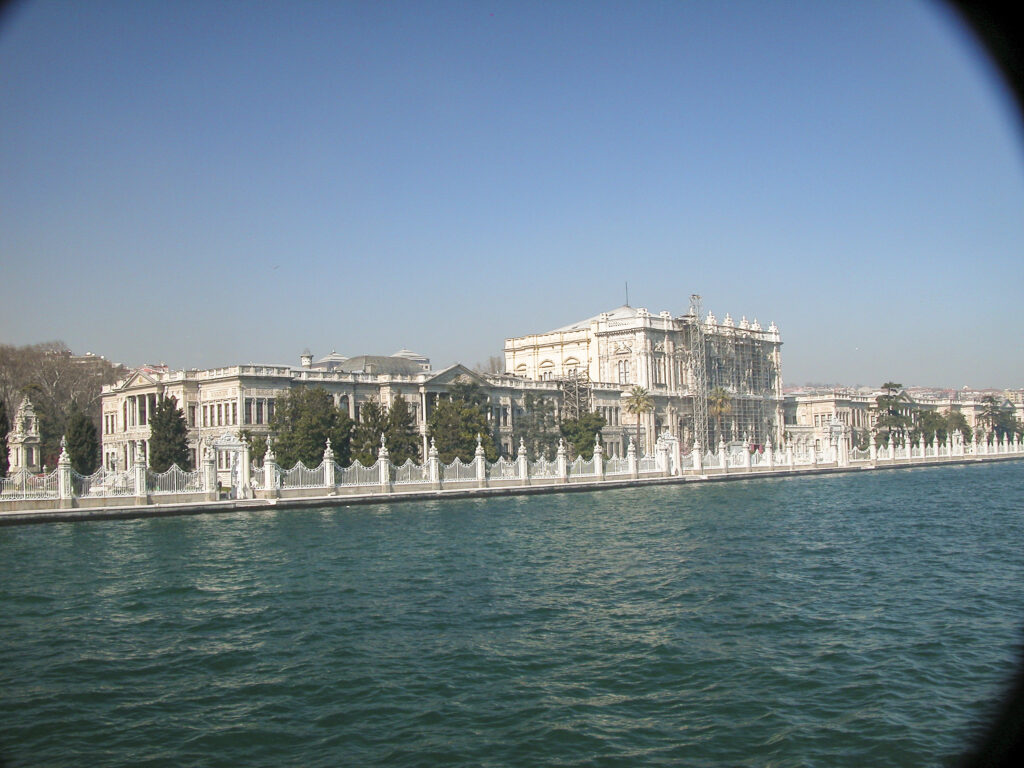
The Dolmabahçe Palace has been characterized as the largest in Turkey, but I think that needs to be qualified as “the largest contained in a single building.” The Dolmabahçe Palace has an area of 45,000 square meters, with the palace grounds taking up a total area of 110,000 square meters, while the Topkapı occupies at least 592,600 square meters.
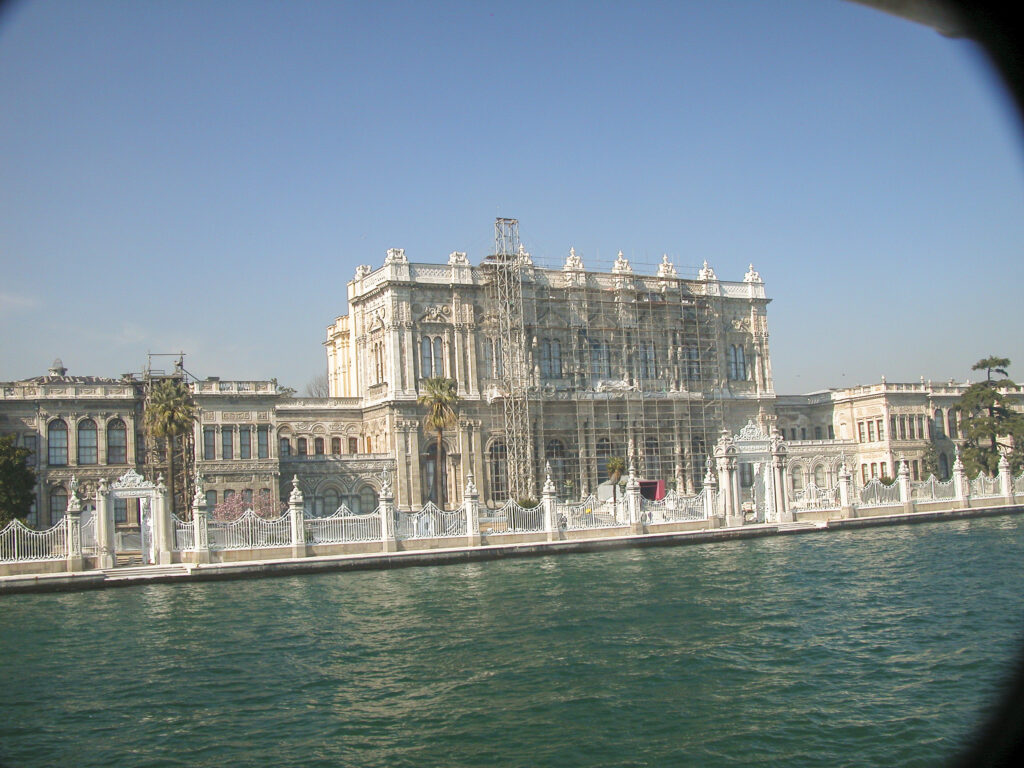
The Dolmabahçe Palace did not leave the past entirely behind. It still had a harem with eunuch guards. The southern wing, or Selamlık, was the more “public” area, where foreign diplomats and other visitors were received; the harem, containing the private residential quarters of the imperial family, was in the northern wing, with separate entrances to assure isolation from the outside world.
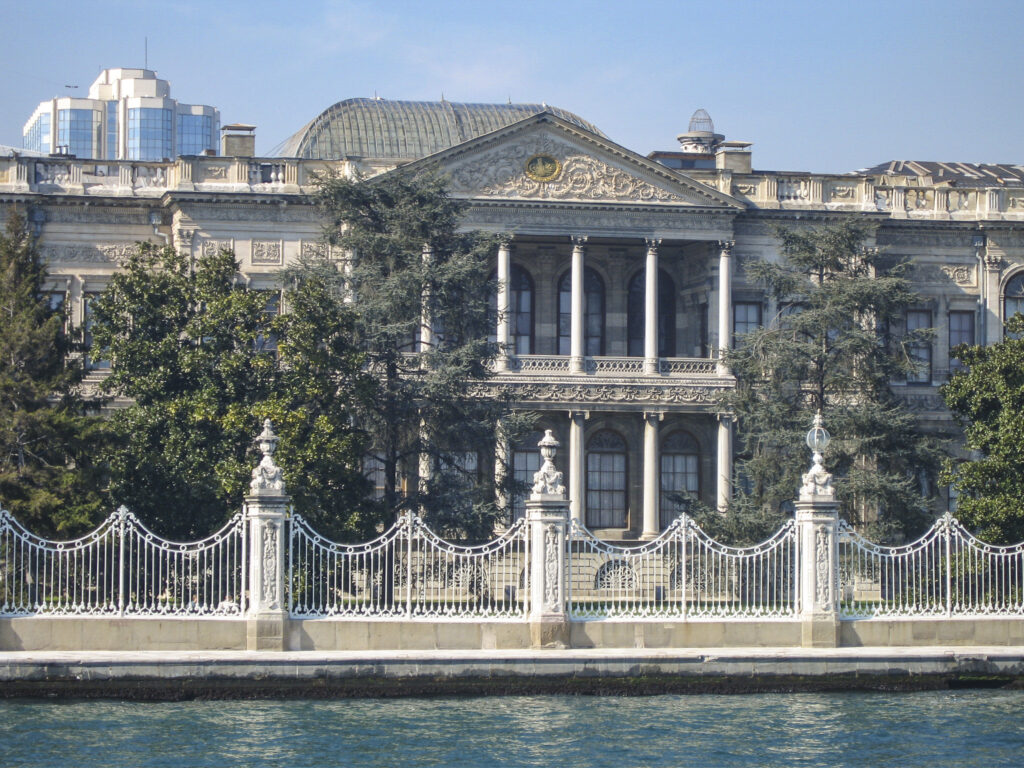
The Harem was connected to the Selamlık by a long, narrow corridor manned by eunuch guards. As in the Topkapı Palace, the harem contained quarters for official wives, the Queen mother (Valide Sultan), favorites (Gozde) and concubines (Cariye), as well as schoolrooms for the young children of the sultan. When the princes reached puberty, they were no longer quartered in the harem, but rather (as I mentioned in the Topkapi Palace Harem post) given quarters of their own where they were confined and closely watched so they could not make trouble for the reigning sultan.
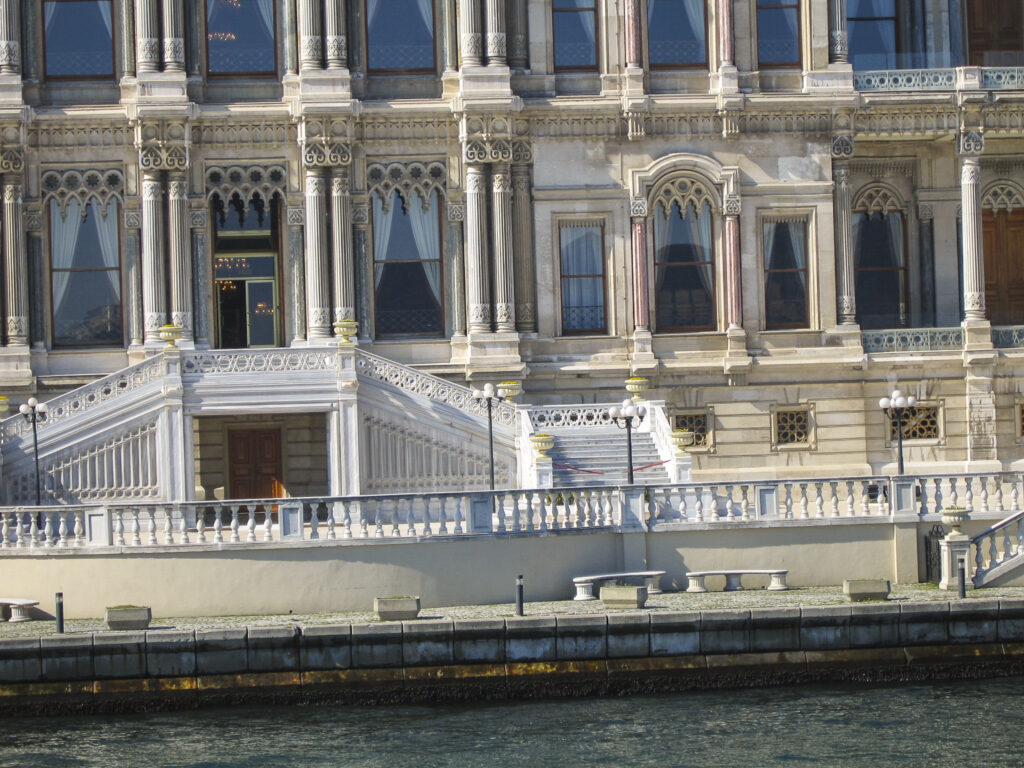
In fact there was a separate palace for the Crown Prince on the east side of the Dolmabahçe Palace, not connected to the harem; it is now the National Palaces Painting Museum (Milli Saraylar Resim Müzesi). By this time (late 19th century) the Kafes or Cage in the Topkapi Palace was no longer in use, and junior princes were confined in other palaces such as the Beylerbeyi on the Asian side of the Bosporus.
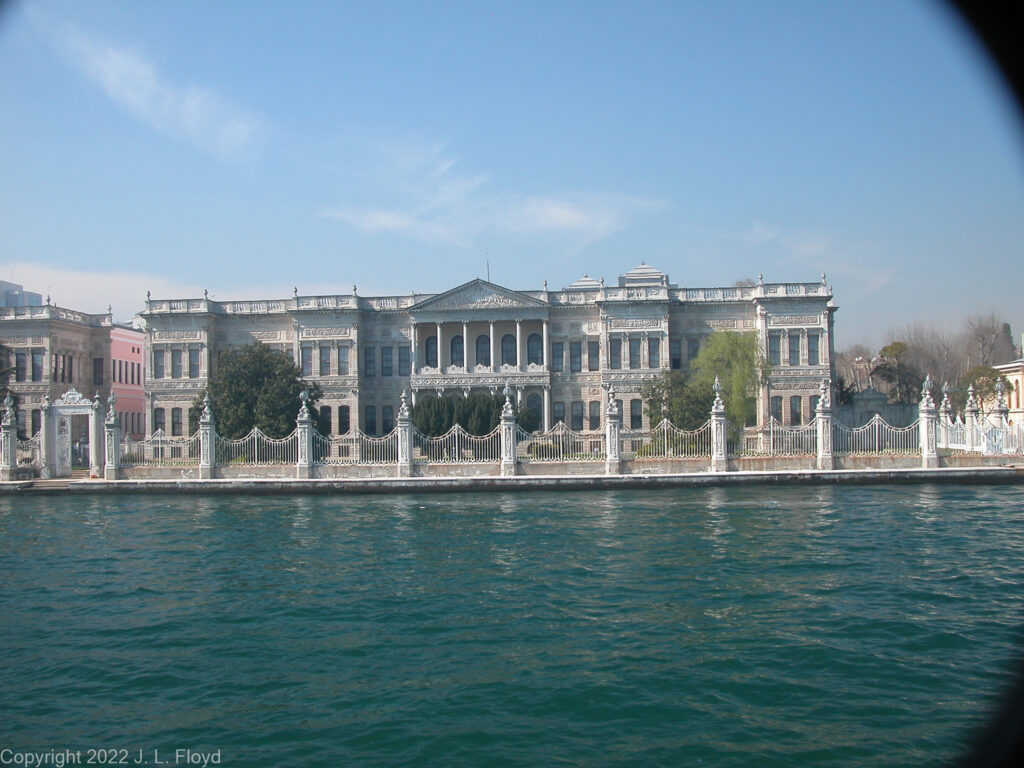
Not long after passing the Dolmabahçe Palace, we encountered another 19th-century Ottoman palace, the Çırağan. It would not be the last; it seems that in the 19th century the Ottoman sultans decided that it was too déclassé to live in the palaces of their predecessors, and started a tradition (short-lived, as it turned out) of each sultan building his own new palace upon his accession. The Çırağan Palace was built for Sultan Abdulaziz (r. 1861-1876), who entrusted both design and construction to the Armenian Balyan family, who provided virtually all the Ottoman palace architects in the 19th century. Construction was completed in 1867. Abdulaziz was deposed in a coup in 1876 and shortly afterward died, most likely by suicide. His immediate successor, his nephew Murad V, then moved into Çırağan, only to be deposed himself by his brother Abdulhamid II by reason of mental incompetence. But Murad continued to live in the Çırağan Palace until his death in 1904. Abdulhamid II had his own new palace, the Yildiz (Star), built in 1880, in a complex on the hill above the Çırağan, but it was not visible from our cruise boat.
In 1909, after the Young Turk revolution had swept Abdulhamid II into retirement, the Çırağan Palace became the meeting place of the new Ottoman Parliament; unfortunately it was nearly destroyed by a catastrophic fire shortly thereafter. Only the outside walls remained intact, and for years the property was used as a football field. In 1987 a Japanese company purchased the ruined palace and had it restored, adding a new hotel building next to it. Currently the property is owned by the Kempinski Hotels chain, which operates the restored palace as luxury suites for the hotel, with the top-rated Sultan’s Suite going for US$35,000 per night.
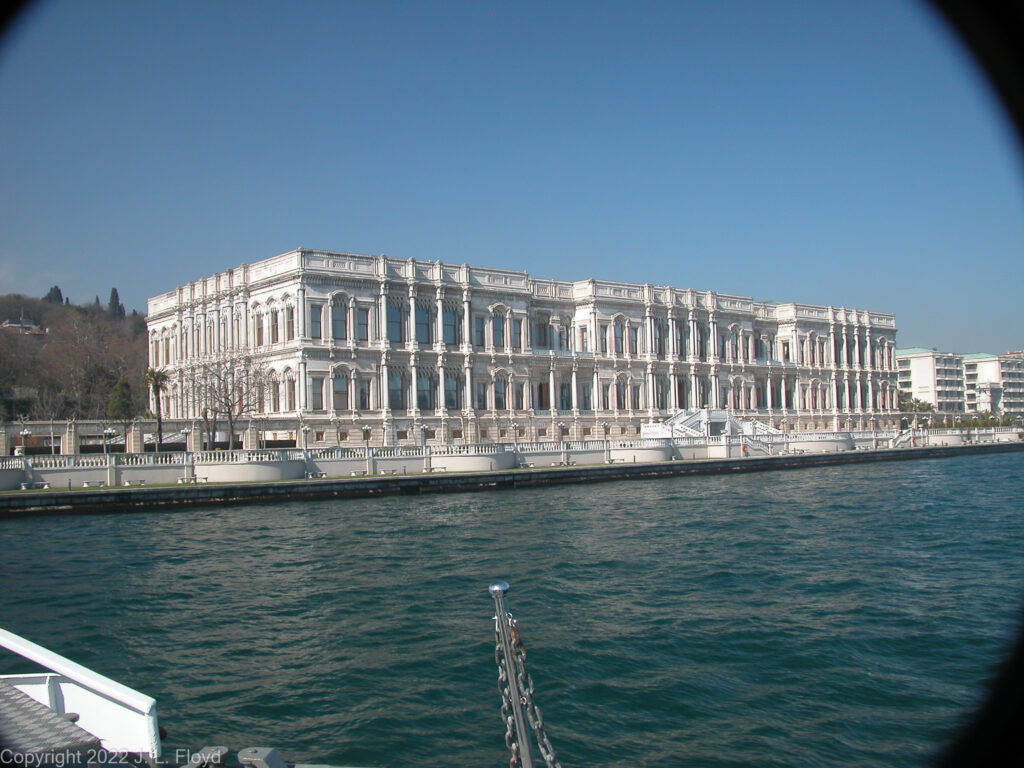
Our Bosporus cruise was set up to follow the European shore on the way out and the Asian shore on the way back. Our itinerary took us under two colossal bridges spanning the Bosporus. The older of the two, built in 1973, was known at the time of our visit to Istanbul simply as the Bosporus Bridge, but in 2016 it was renamed the July 15th Martyrs’ Bridge in memory of the soldiers who were killed resisting the attempted military coup on that date. At the time of its completion, it had the fourth longest suspension bridge span in the world, and the longest outside the USA, but since then a lot of other bridges have been built and it is now only the fortieth longest.
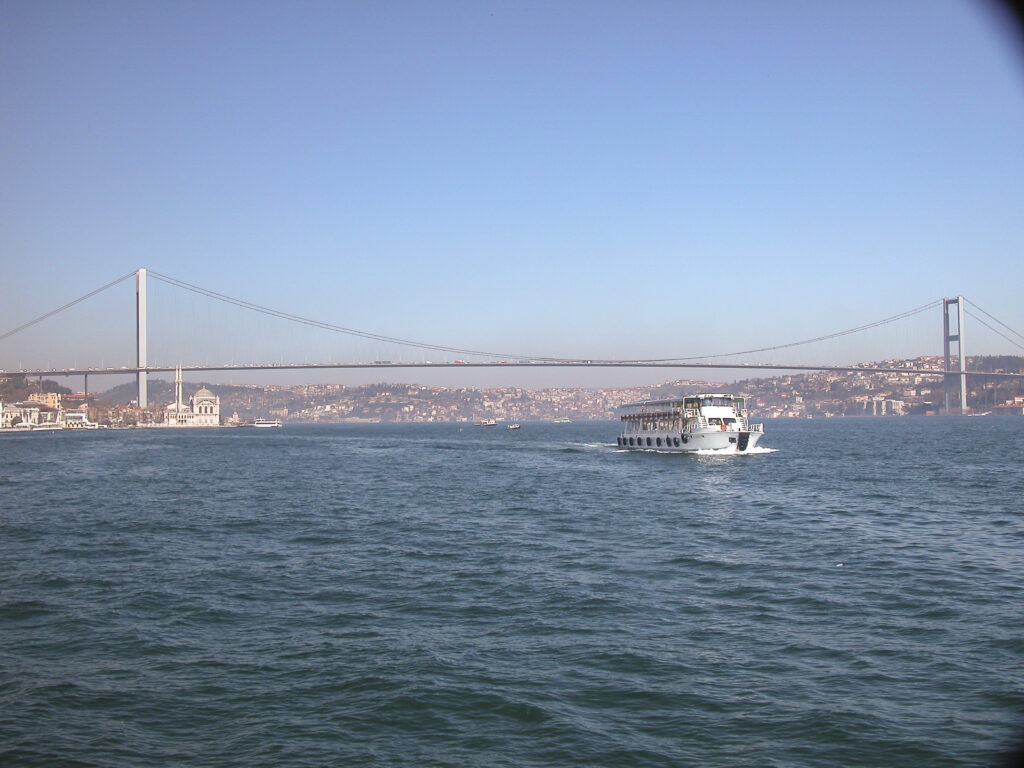
In the shadow of the Bosphorus Bridge stands the Ortaköy Mosque, formally titled the Büyük Mecidiye Camii, or Grand Imperial Mosque, of Sultan Abdülmecid. It was built between 1854 and 1856, in the then-fashionable Neo-Baroque style. The architects were (who else?) members of the Armenian Balyan family of court architects.
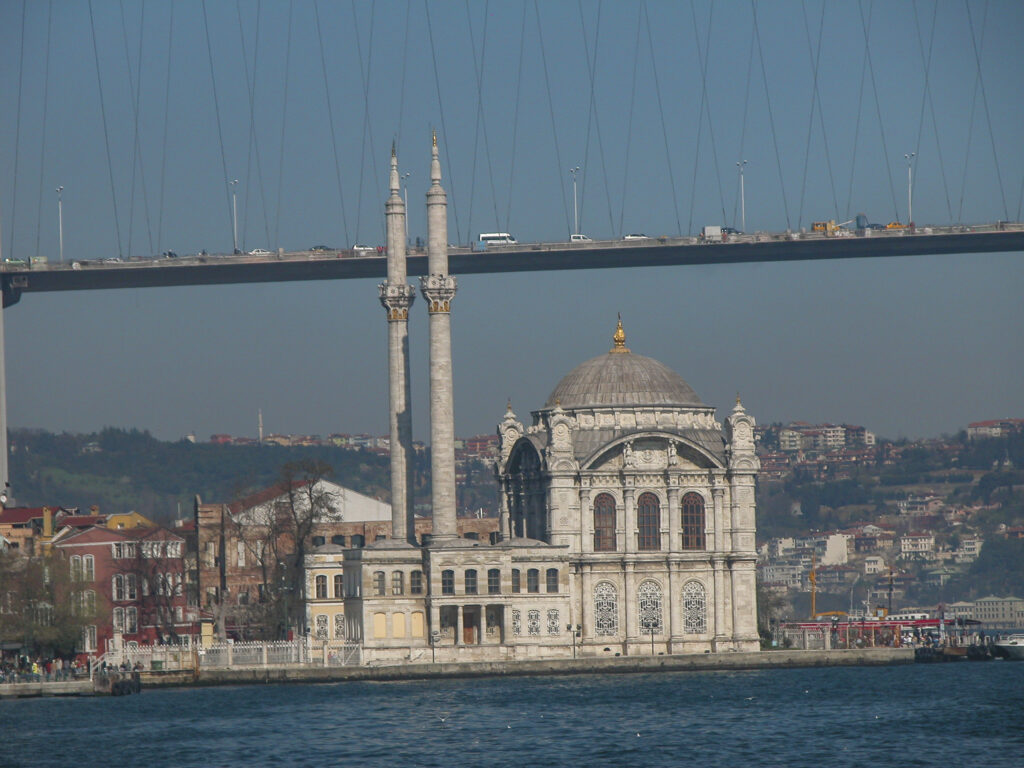
The Ortaköy Mosque is rather modest in size, especially by comparison with the great mosques in the central area of Istanbul, but it stands out nonetheless, partly because of its location and partly because of its unusual design. Although we did not have a chance to visit the interior, I understand from descriptions and photos that the high bay windows are cunningly crafted to refract the light entering them – both direct sunlight and light reflected off the water – so as to flood the interior with a soft and serene radiance.
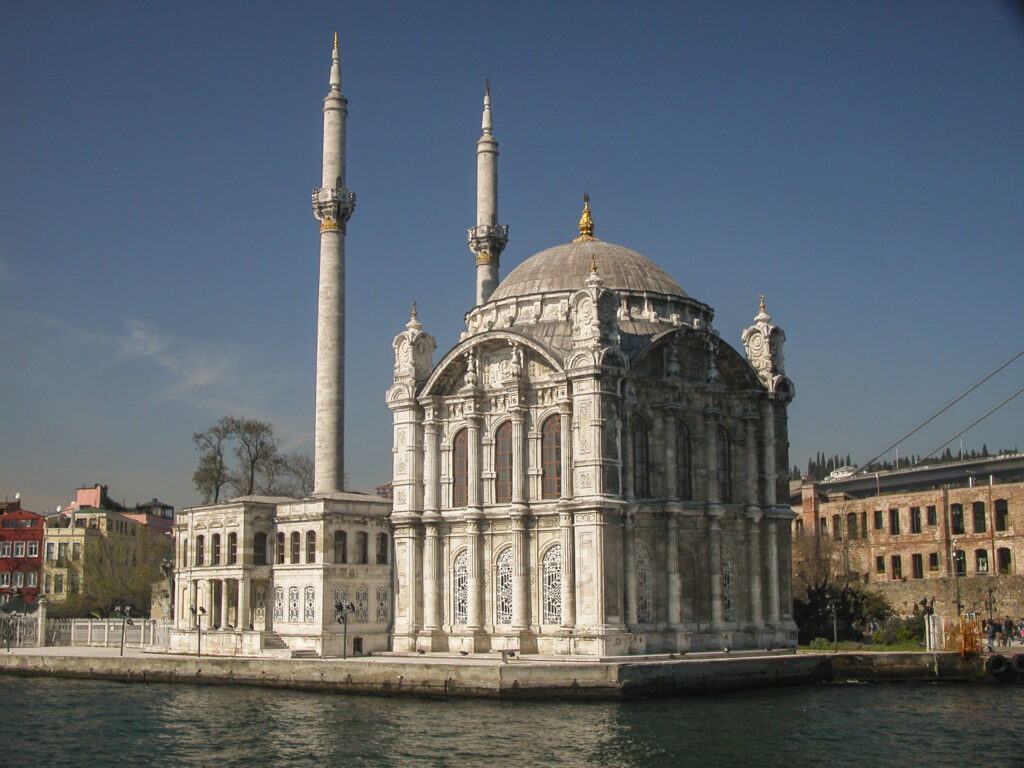
We reached the northernmost point of our cruise at the Fatih Sultan Mehmet Bridge (“Sultan Mehmet the Conqueror Bridge”), about which more in a moment, but just before reaching it our eyes were drawn to an imposing castle with fortifications frowning down on the Bosporus. This was the Rumelihisarı, built in 1451-2 on the orders of Sultan Mehmet the Conqueror in preparation for the siege of Constantinople. The idea was to blockade the Bosphorus against any possible effort by Christian forces to break the siege. (It worked.) The little blue-and-white-striped tower on the waterfront, toward the center of the picture, is the modern Aşiyan lighthouse.
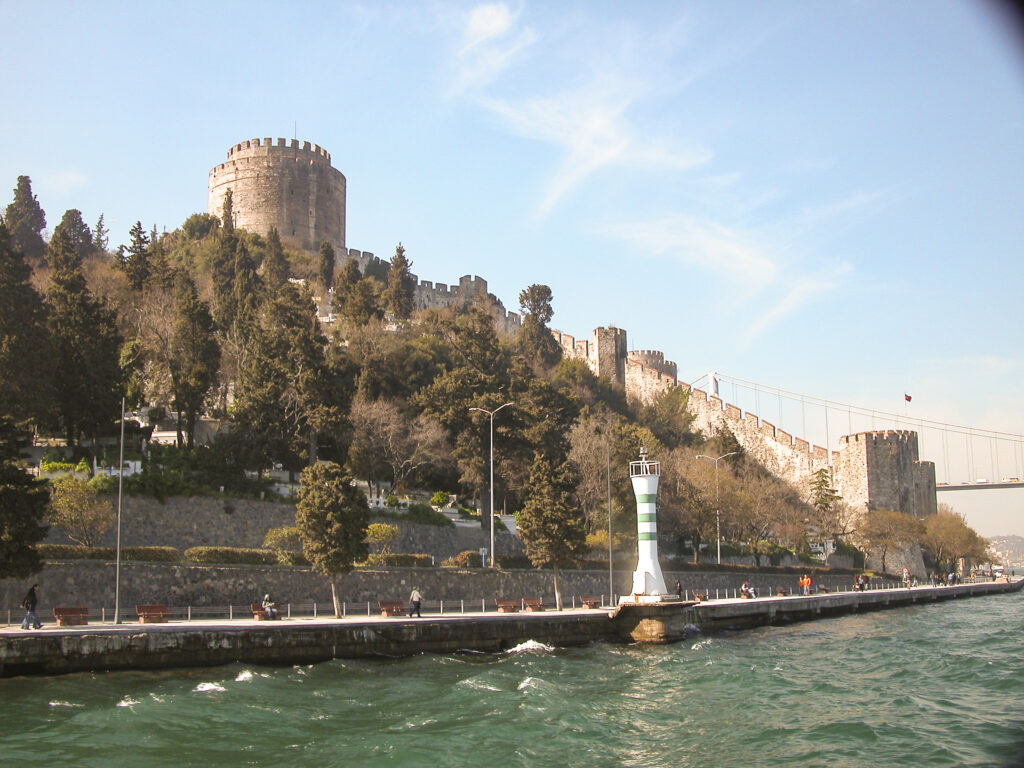
The original name of Rumelihisari was “Boğazkesen”, which means “strait-cutter”; but “boğaz” means “throat” as well as “strait” in Turkish, so the implication was that it was going to cut the throat of the Byzantine Empire – which it did.
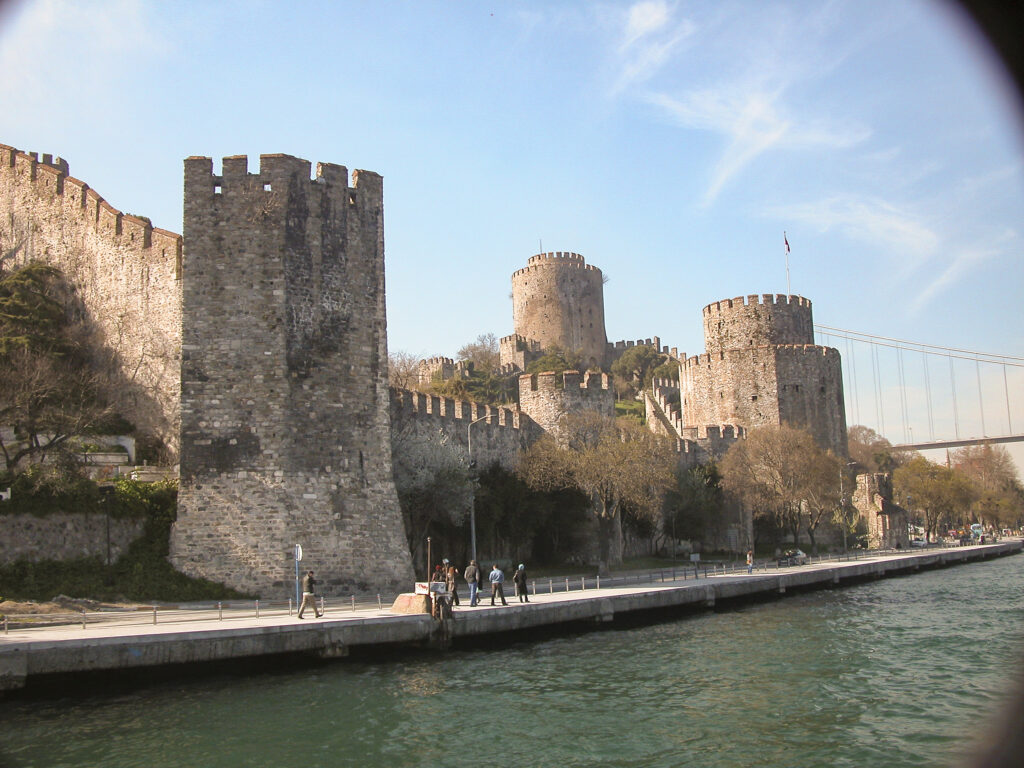
After Rumelihisarı had served its original purpose in securing the fall of Constantinople, the Ottomans turned it into a border checkpoint and customs-house; they also used it at times as a prison. But nowadays it houses a museum open to the public and also provides a venue on its grounds for concerts, art festivals and other outdoor events.
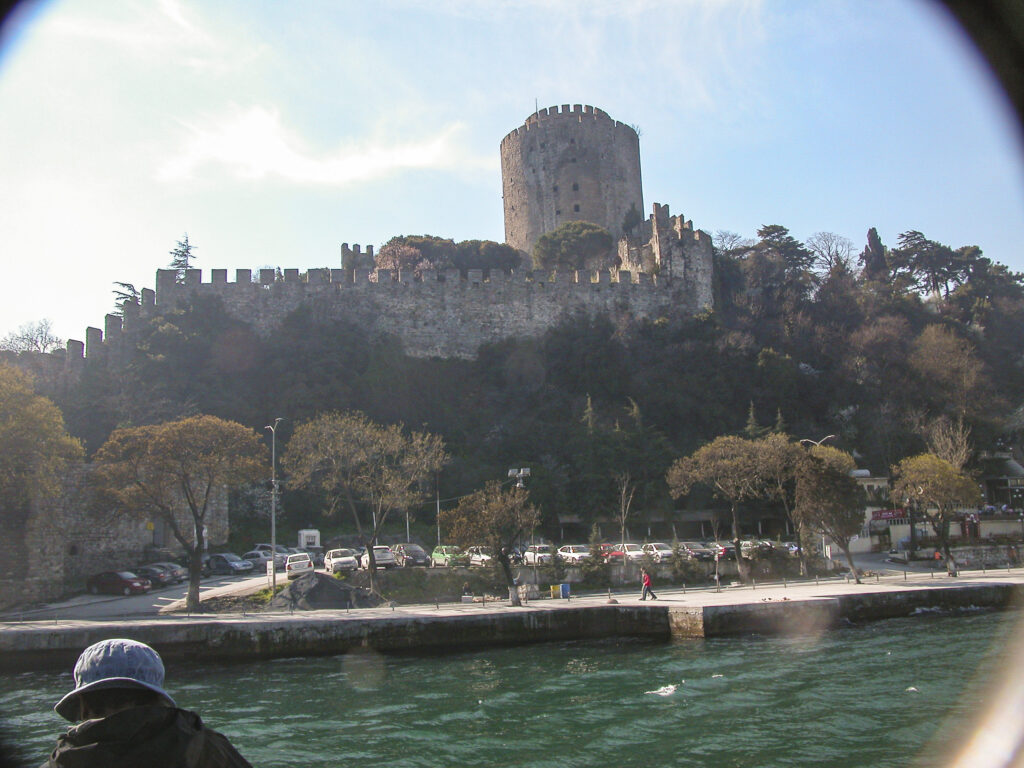
On the Asian side of the Bosphorus, opposite Rumelihisarı, stands an even older Ottoman castle, Anadoluhisarı. By 1394 the Ottoman Sultan Bayezid I had conquered much of the Balkans and Anatolia and was preparing to deliver the coup de grâce to the Byzantine Empire; he had Anadoluhisarı built as part of his preparation for the siege of Constantinople. The Byzantine Emperor Manuel II Paleologus tried to organize a Crusade to raise the siege, and he did succeed in getting the King of Hungary and a few others to come to his aid, but Bayezid smashed the Crusaders and the siege continued. Unfortunately for Bayezid, however, he made the mistake of antagonizing one of the most fearsome conquerors in history, the Turco-Mongol warlord Timur the Lame or Tamerlane. In 1402 Timur’s forces routed the Ottoman army at Ankara and routed it; Bayezid was taken captive and died in captivity. His sons thereupon immediately began fighting over the succession, and although Timur removed himself from the scene by going off to invade China, and dying on the way (1405), the defeat and the civil war over the succession resulted in a period of chaos known as the Ottoman Interregnum, giving the Byzantines a half-century reprieve. But this only delayed the inevitable; eventually the Ottomans got their act back together and resumed the onslaught on Constantinople. In 1453 Sultan Mehmed II used Anadoluhisarı in tandem with his newly-built fortress of Rumelihisarı to cut off all traffic along the Bosphorus and thus seal the fate of Constantinople.
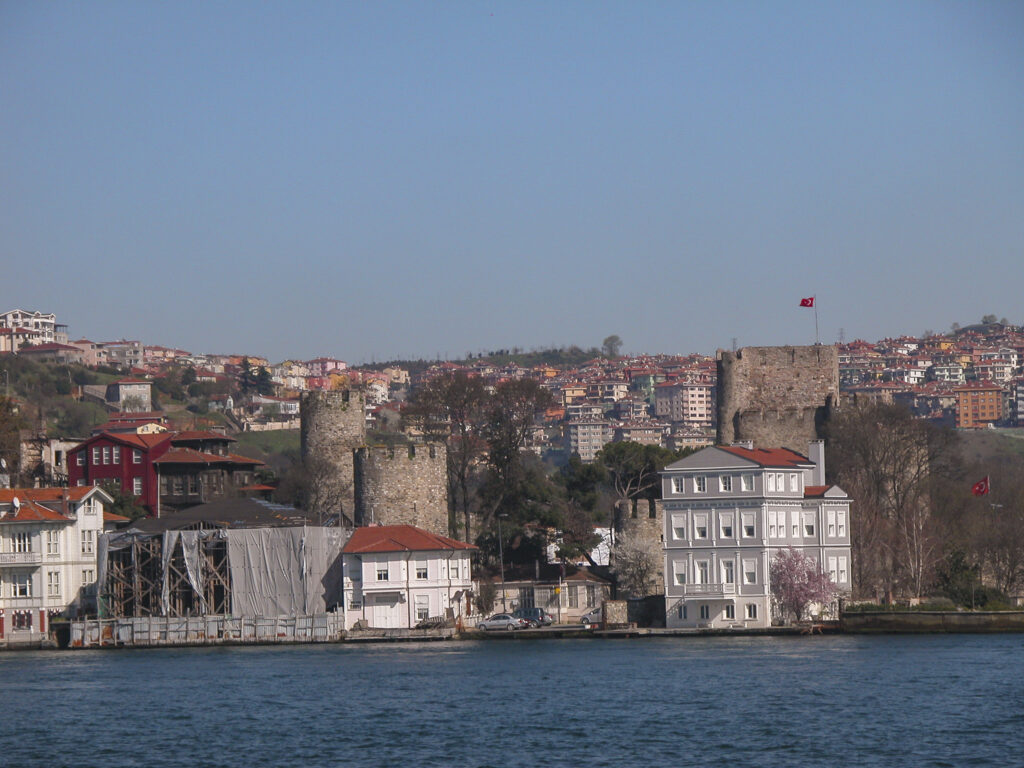
A little way beyond the Rumeli-Anadoluhisari structures stands the second of the great Bosphorus bridges, named after the Sultan who led the conquest of Constantinople in 1453. When completed in 1988, it was the 5th-longest suspension bridge span in the world; now it is the 36th. (They build a lot of long bridges these days. At the time of this writing the longest is the 1915 Çanakkale Bridge over the Dardanelles, a strait that Xerxes of Persia bridged with boats to facilitate his invasion of Greece in 480 BC.) It carries European route E80, the Trans-European Motorway, between Edirne and Ankara, and about 150,000 vehicles cross over it each day.
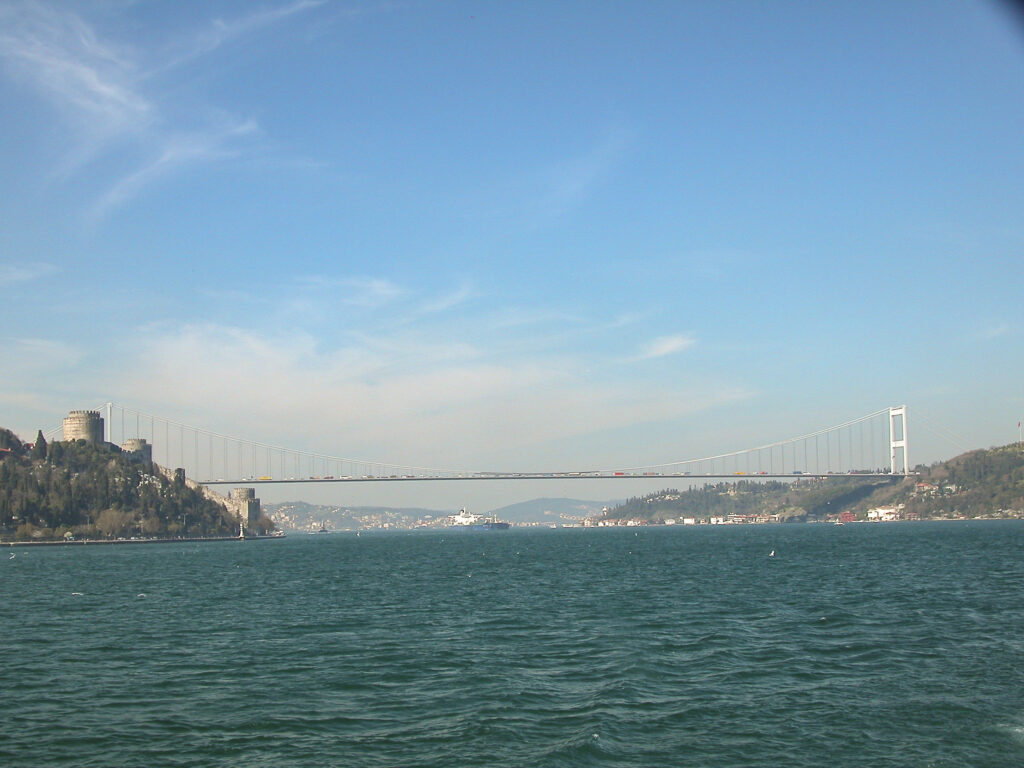
Within a stone’s throw of Anadoluhisari, on the Asian side of the Bosphorus, stands the Küçüksu Palace (or Küçüksu Pavilion, Küçüksu Kasrı in Turkish), a small palace or large pavilion, depending on your preference. Commissioned by Sultan Abdulmejid I, who entrusted the architecting to the (you guessed it!) Armenian Balyan family, it was finished in 1857. It was a summer palace and was used mainly as a country retreat and hunting lodge – the area was presumably much more rural in the 19th century than it is now.
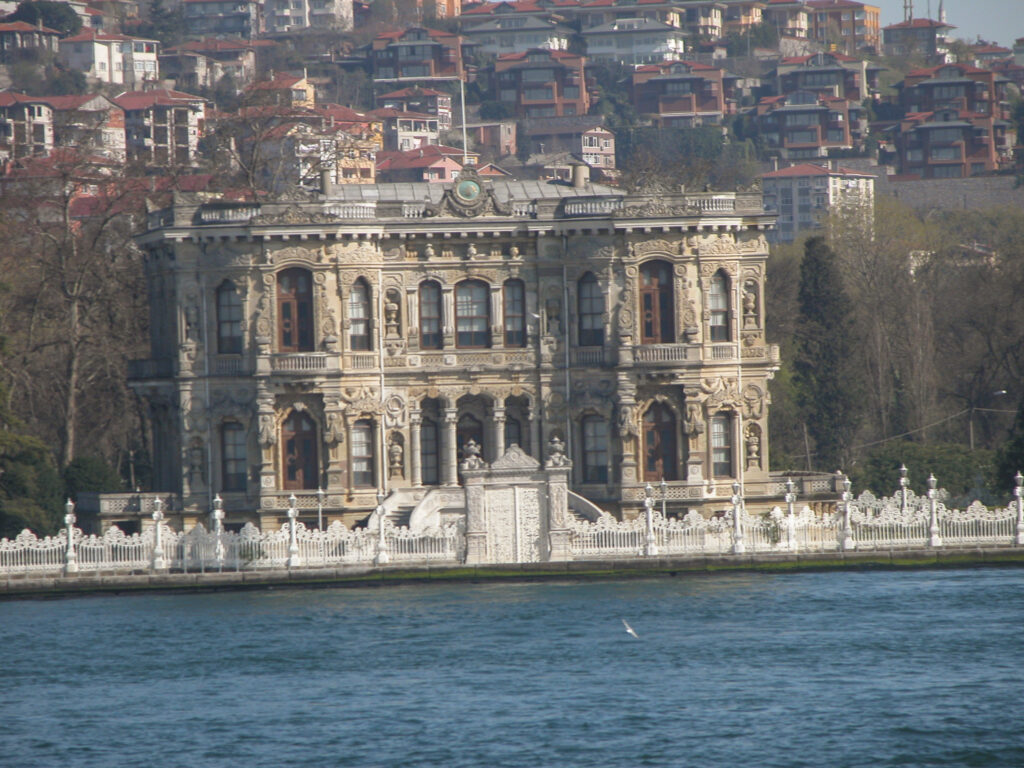
Turkish sultans were not the only persons building palaces along the Bosphorus. From the 18th century onward, it became fashionable among the Turkish elite to build waterside mansions called yalı. They generally built the yalis as second homes to use for seaside vacations. According to Wikipedia there are 620 of them, scattered on both sides of the Bosphorus; but their count includes only Ottoman-era yalı, so here I have to make a disclaimer. Knowing nothing about the subject at the time, I photographed them indiscriminately, without worrying about whether they were authentic Ottoman-era yalı, and I’m applying the term to all those that I photographed, some of which clearly date to post-Ottoman times. Furthermore, I have lumped all my yalı shots together, without respect to the order in which I shot them, their locations or ages, so I’m not distinguishing, for example, which ones were on the European and which on the Asian shore.
That said, the yali in the next photo are clearly among the older breed.
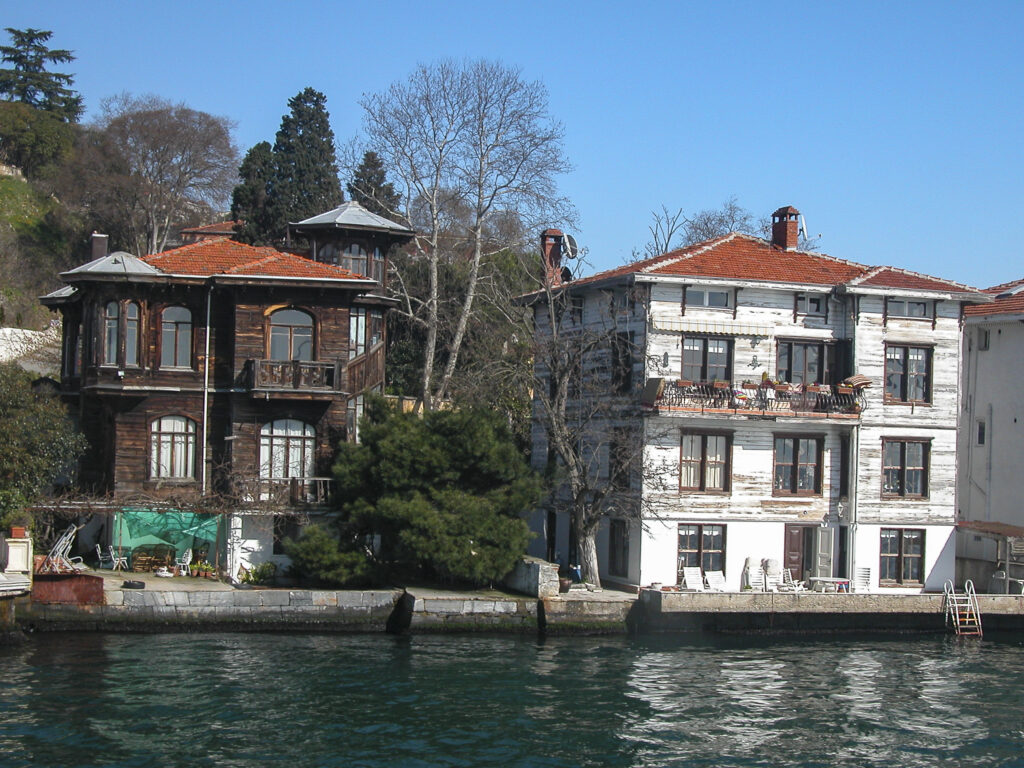
Our guide Attila assured us that the property values along the Bosphorus were among the highest in the world. I’ve since noted that the Erbilgin Yalı was listed in 2009 as being on sale for $100,000,000, making it the fifth most expensive house in the world. It is on the European side, north of the Mehmed bridge, so I didn’t have a chance to shoot it, but you can see a picture of it here.
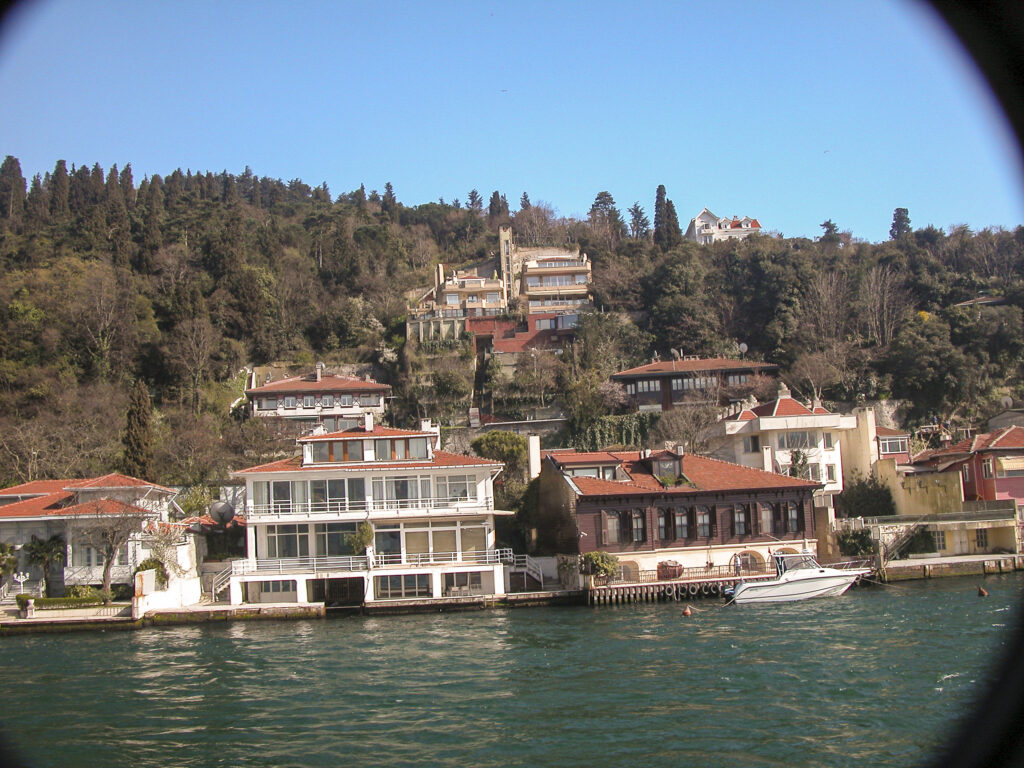
One of my favorites was this identical-twin yalı with the Mansard-style roof. I rather doubt whether this would be classified among the 620 authentic Ottoman yalı – it’s clearly of more recent vintage. I haven’t yet been able to find out any information about it, though.
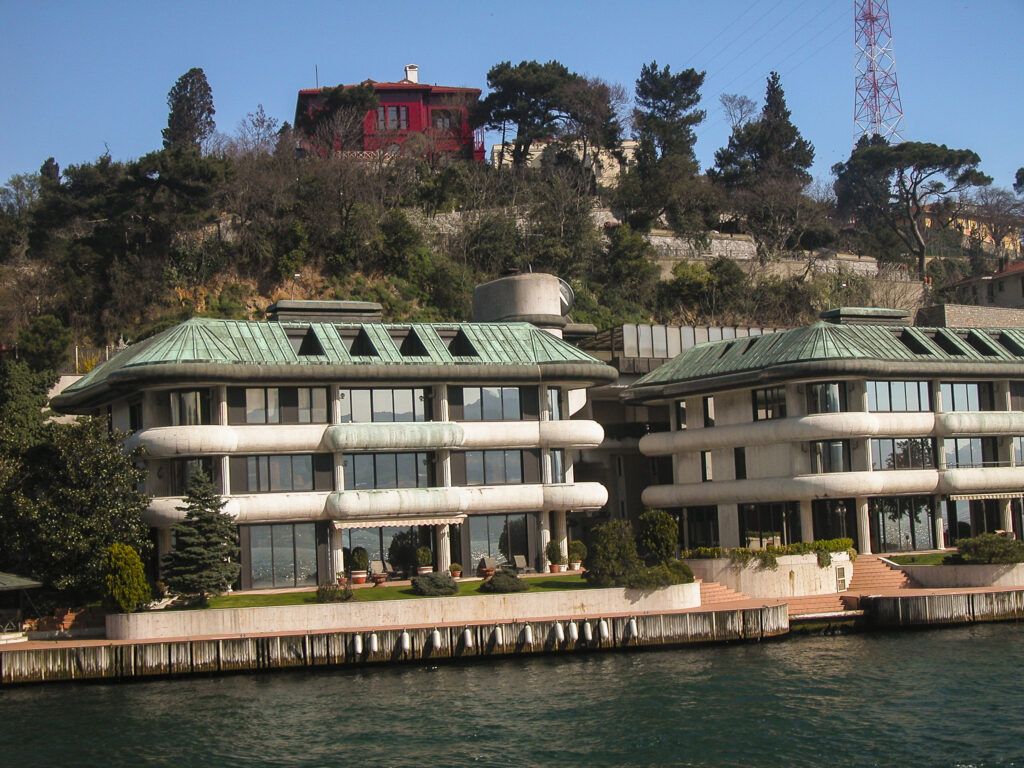
Some houses were built so closely together that they had to be sharing walls. In the rather bizarre scene below three yalı, each with its own quite distinct architectural style, appear to be crammed together on the same foundation.
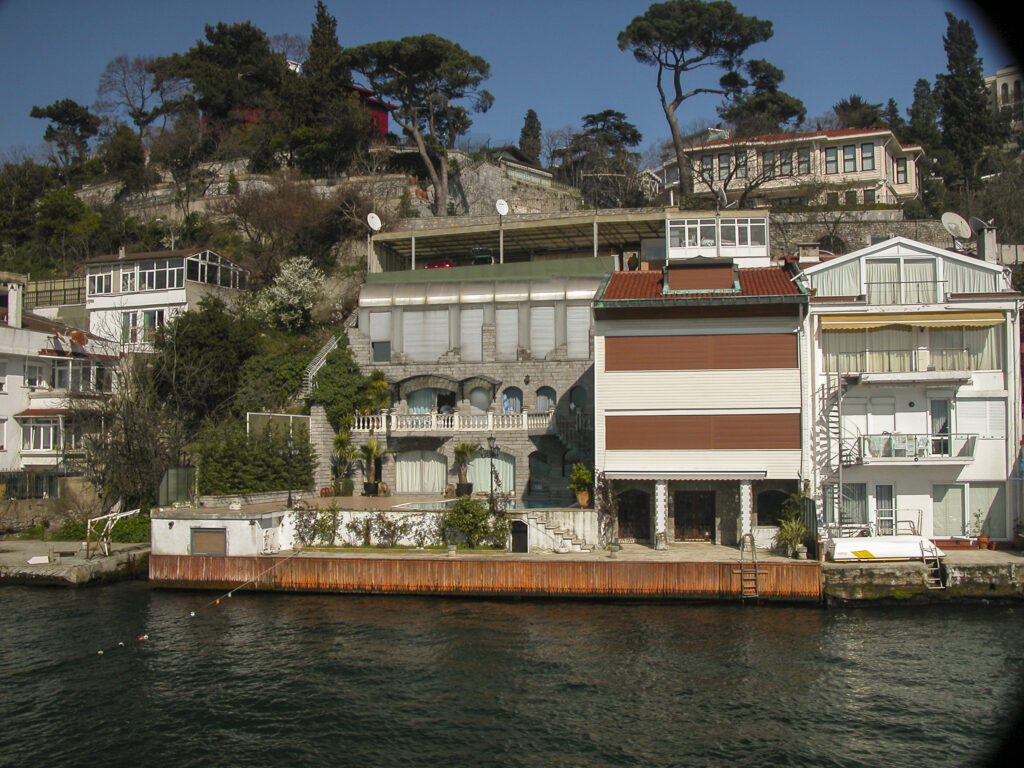
I gave the next yalı the top score for having the most flamboyant color. Actually there are several yalı with similar color schemes, such as the Hekimbasi Yali near Bosphorus Bridge, and the yali of Count Leon Ostrorog on the Kandilli shore, but somehow I missed those.
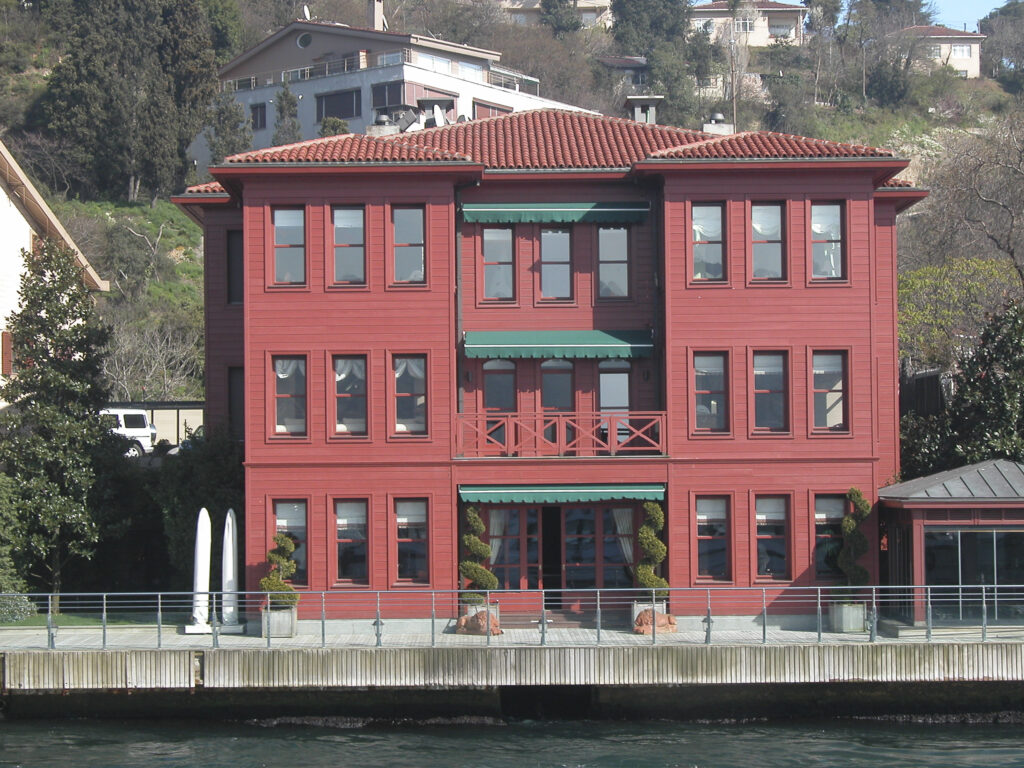
The next photo represents an unusual sight in what was otherwise a very upper-crust neighborhood. I guessed that it was probably an old house in the process of being torn down and replaced with a new one. I suppose it could also be an old house in the process of restoration, but given the extent of the devastation, that seems unlikely.
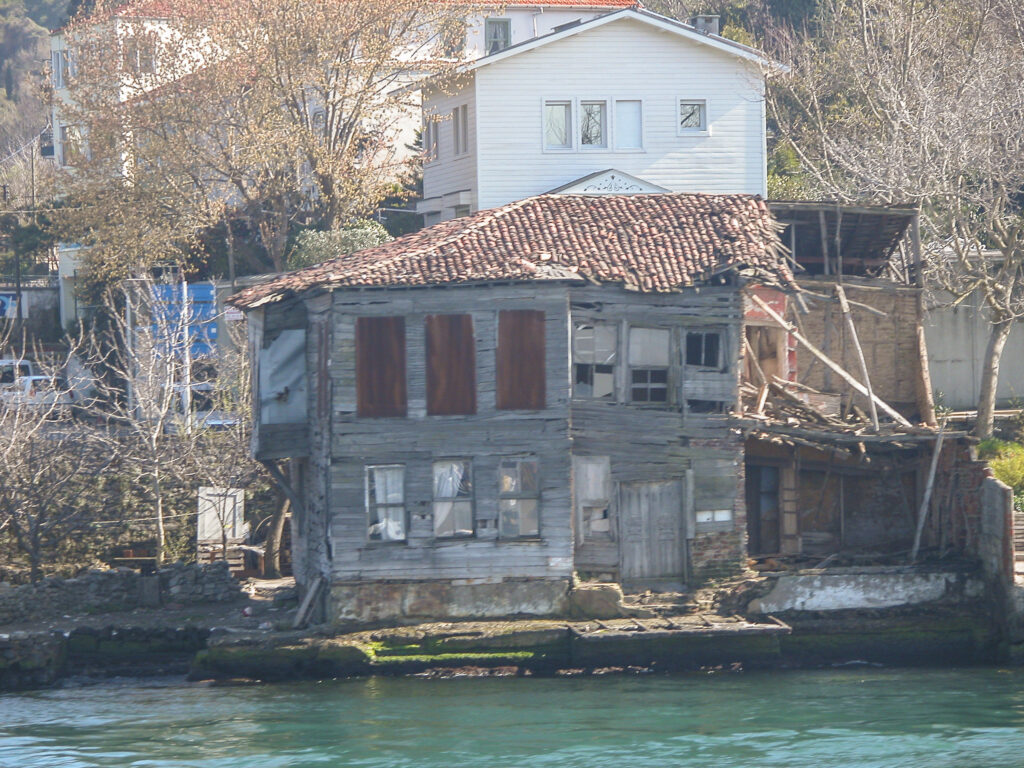
The price of real estate along the Bosphorus means that many yalı owners, who are among the well-to-do but not super-rich, have to squeeze the most possible value out of every square centimeter of their land, so they built up rather than out. It’s the same principle that led to building skyscrapers in New York. This yalı took the honor of being the skinniest.
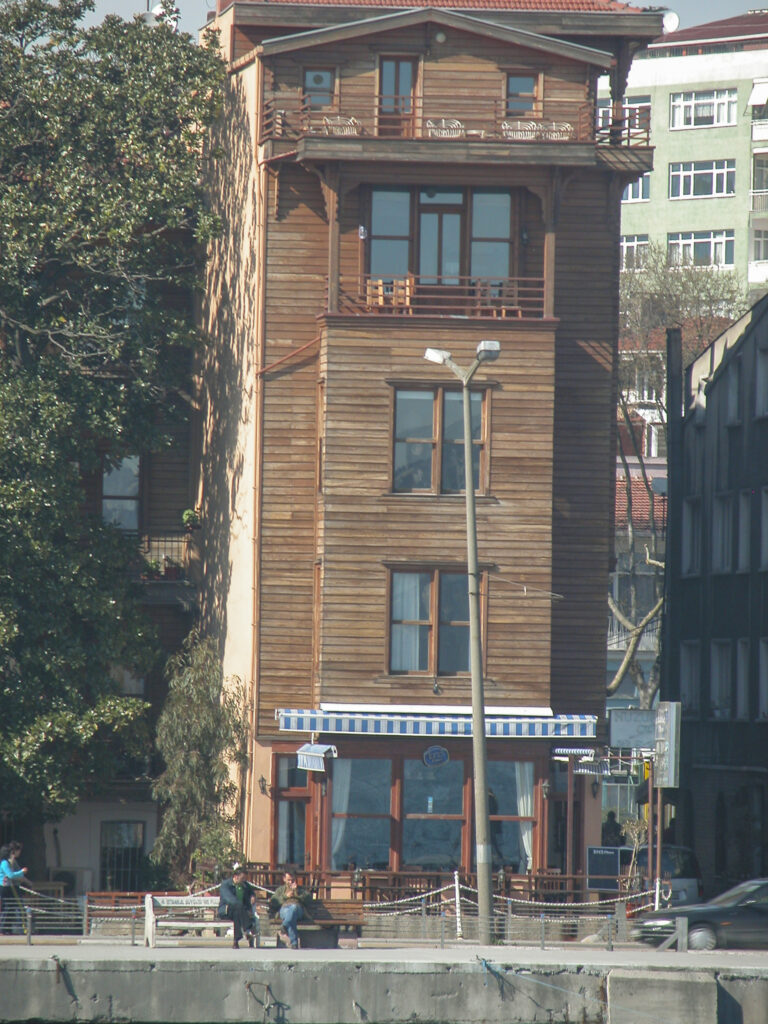
Judging from the looks of this place, I’d guess that it was no yalı but a neighborhood mosque.
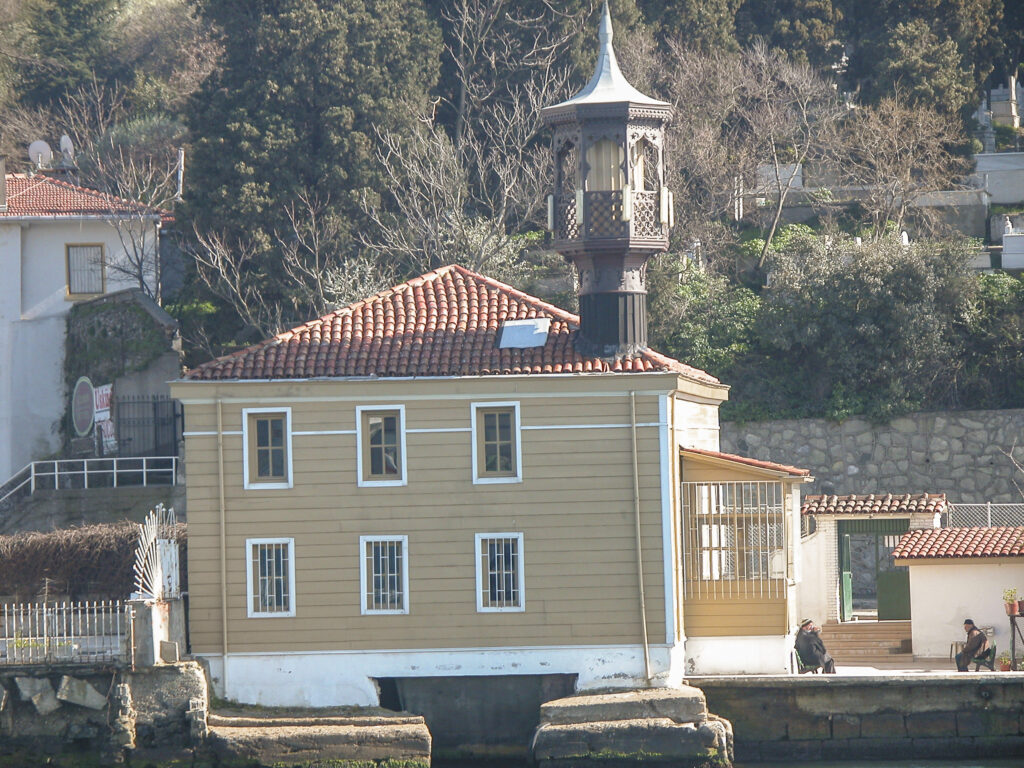
On our way back down we passed the Kuleli Military High School, the oldest military high school in Turkey, founded by Sultan Abdülmecid I in 1845. Prior to housing the school, the building had been built as the Kuleli Cavalry Barracks. The architect, of course, was Garabet Balyan. After the attempted coup d’état of July 15, 2016, the Erdogan regime issued a decree closing all the military high schools, including Kuleli, which was turned into a museum.
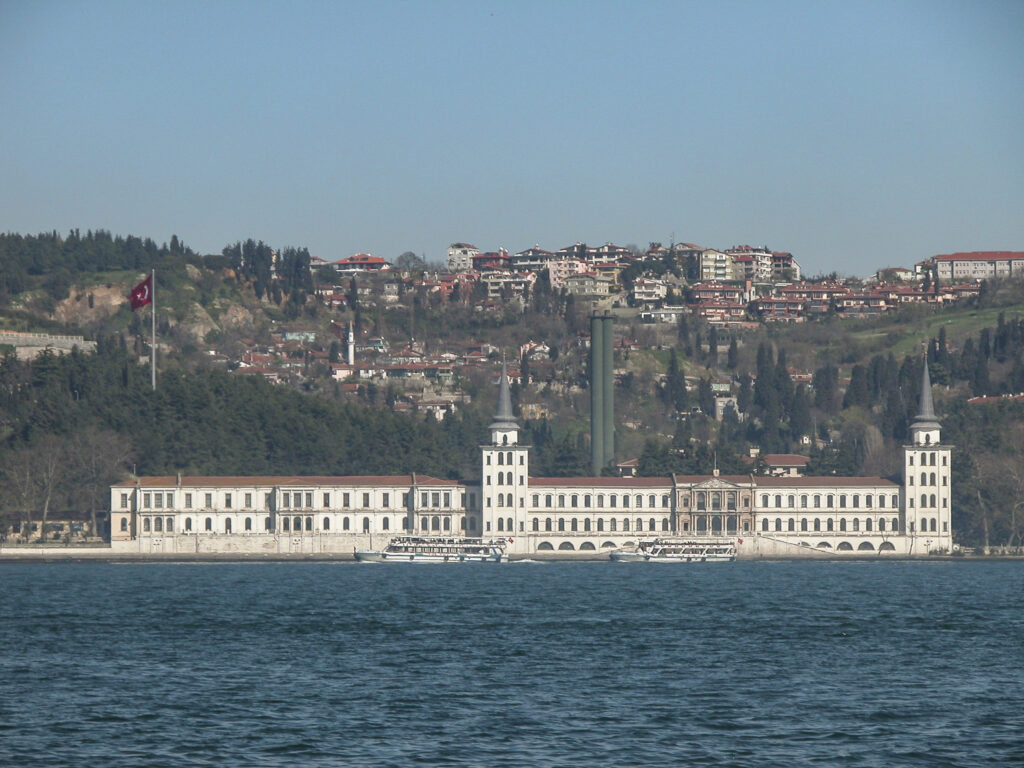
Just before passing back under the Bosphorus (15 Martyrs) Bridge, we passed the Beylerbeyi Palace, one of the last few Ottoman palaces to be built, in 1861-1865. Sultan Abdülaziz (1830–1876) intended it as a summer residence and a place to entertain visiting heads of state. The architect was (surprise!) Sarkis Balyan. Abdülaziz did indeed use the Beylerbeyi Palace to put up foreign dignitaries; one of them was the Shah of Iran, and another was Empress Eugénie of France, wife of Napoleon III, in 1868. Eugenie enjoyed her stay in Beylerbeyi, but things did not go so well when Abdülaziz took her to meet his mother, the Valide Sultan Pertevniyal, in the Dolmabahçe Palace. Pertevniyal reportedly considered it an outrage that an infidel foreign woman would dare to venture into her private quarters, and slapped Eugénie in the face (or on the tummy, according to another account). The incident, if it did occur, was quickly swept under the rug (which, being a luxurious Turkish carpet, smoothed it over very well), and apparently it had no lasting repercussions.
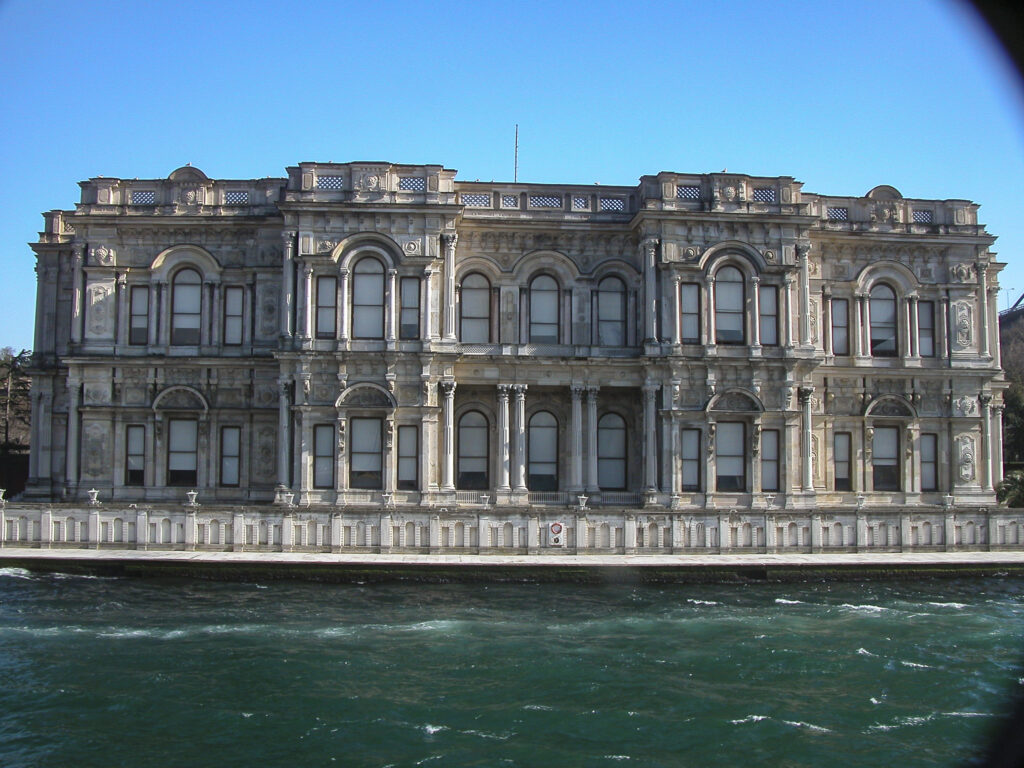
Nearing the end of our Bosphorus odyssey, we passed the older and smaller (but still quite substantial) of two 16th-century mosques commissioned by Mihrimah Sultan, daughter of Suleiman the Magnificent and husband of one of his Grand Viziers, Rüstem Pasha. (The other one is located in the Edirnekapı neighborhood of Fatih district, on the European side.) Imperial architect Mimar Sinan, greatest of classical Ottoman architects, was the designer, and the mosque, completed in 1548, is considered a fine example of his mature style. It is one of the most prominent landmarks in the Üsküdar district of Istanbul.
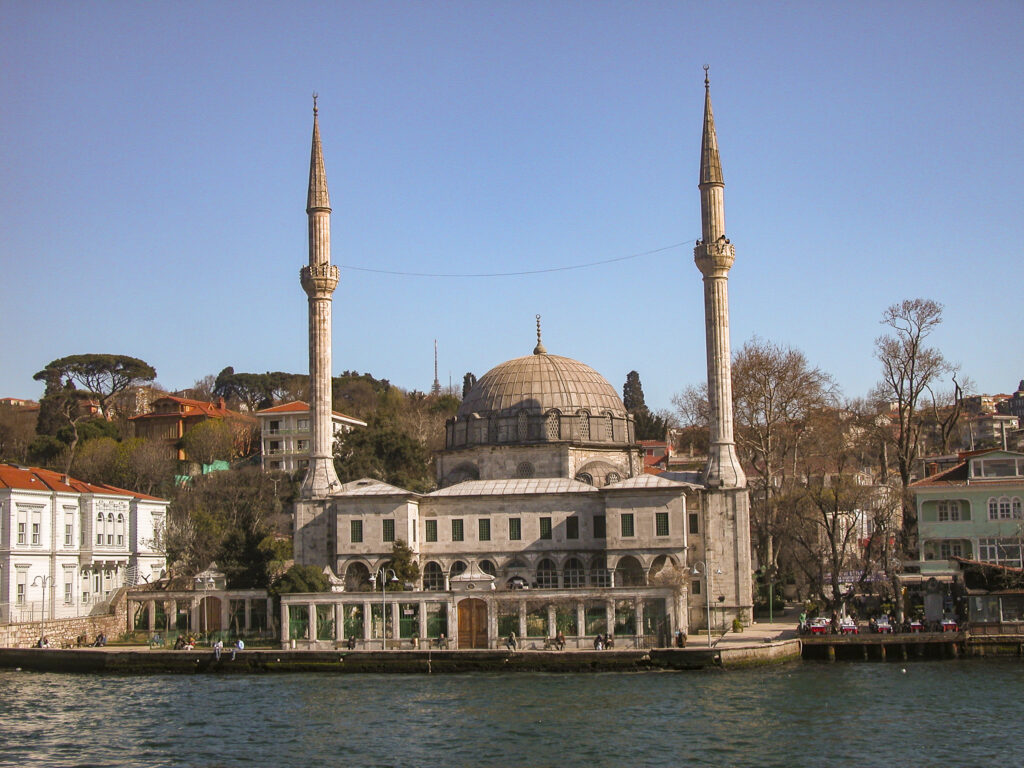
As the cruise boat turned back across the Bosphorus toward the dock, it passed close by a tower perched on a tiny islet off the Asian shore, known as Kiz Kulesi, or Maiden’s Tower. The name comes from a legend that one of the Byzantine emperors had a beautiful daughter whom he loved greatly, but an oracle predicted that she would be bitten by a venomous snake and die on her 18th birthday. The emperor built a tower on the islet and confined his daughter there to keep her safe from snakes. On her 18th birthday the emperor, rejoicing that he had foiled the prophecy, took her a basket of fruit as a birthday gift. Unbeknownst to him, an asp had sneaked into the basket and was hiding amongst the fruit. Of course you can guess what happened next. There are other legends connected with this tower, but they all seem equally improbable and I’ll leave readers to investigate them if they so desire.
More in accord with historical fact, there seems to have been a tower on the island at least since ancient Greek times. The Byzantines stretched chains across the Bosphorus from Kız Kulesi to the mainland to close the straits against their enemies. After the conquest of Constantinople in 1453, the Turks used the Maiden’s Tower as a watchtower and a lighthouse. The tower was destroyed several times over the centuries by earthquakes and fires, and repeatedly restored. In its latest incarnation, it has a restaurant inside, to which we would embark the following evening for a farewell dinner.

As our cruise boat neared its dock in Eminönü, we caught sight of another classical Ottoman mosque, the so-called New Mosque (Yeni Cami). The name is misleading; construction began in 1597 under the auspices of Valide Sultan Safiye, the mother of Sultan Mehmed III. But Mehmed died in 1603 and his successor, Ahmed I, apparently resented his grandmother and had no interest in completing her mosque project. In fact, Safiye was widely unpopular and had evoked considerable discontent among the army and the people, not least by her mosque project, which was quite expensive. Thus Ahmed I booted Safiye out of Topkapı and sent her back to the Old Palace. The mosque was left partially constructed. Half a century later, another Valide Sultan, Turhan, was persuaded to complete the mosque as an act of piety. She also initiated the construction of the Spice Bazaar, which we were to visit next.
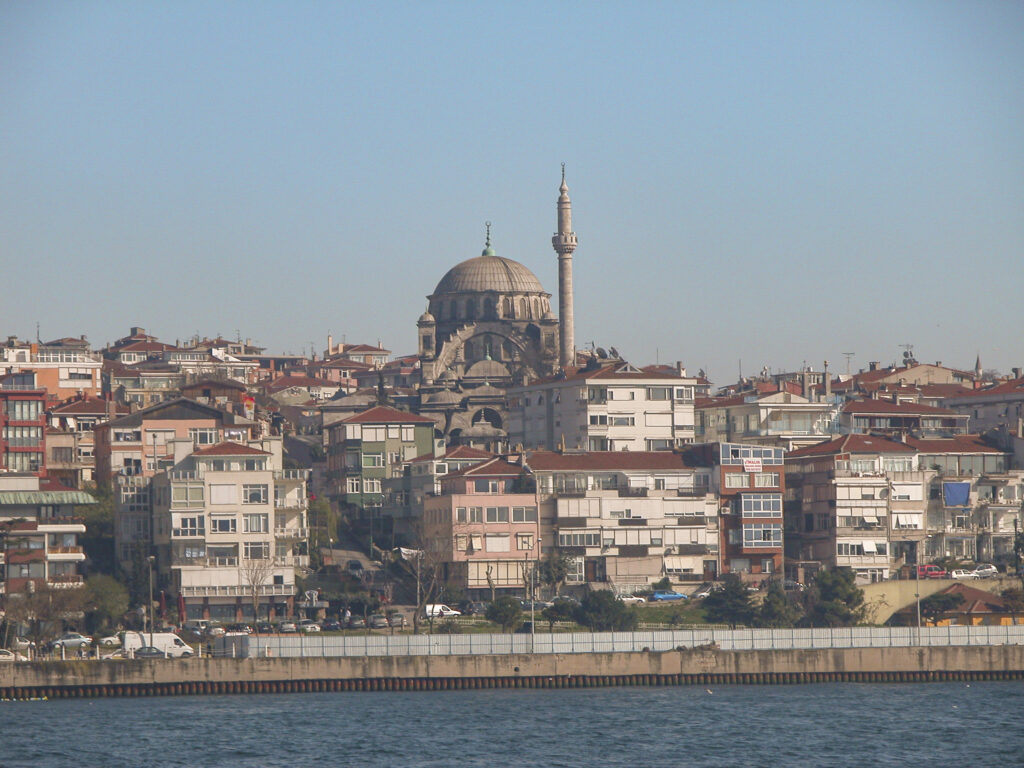
The official name of the Spice Bazaar in Turkish, Mısır Çarşısı, translates as “Egyptian Bazaar,” reflecting the financing of the project, which drew upon the revenues from Egypt, an Ottoman province at the time of construction. After completing the Spice Bazaar in 1664, the Ottoman government rented out the stalls and used the revenues thus obtained to support the upkeep of the New Mosque.
These days the Spice Bazaar is the second largest covered mall in Istanbul, hosting 85 shops, selling not only spices but also sweets, especially Turkish Delight, fruits, nuts, jewelry and tourist souvenirs.
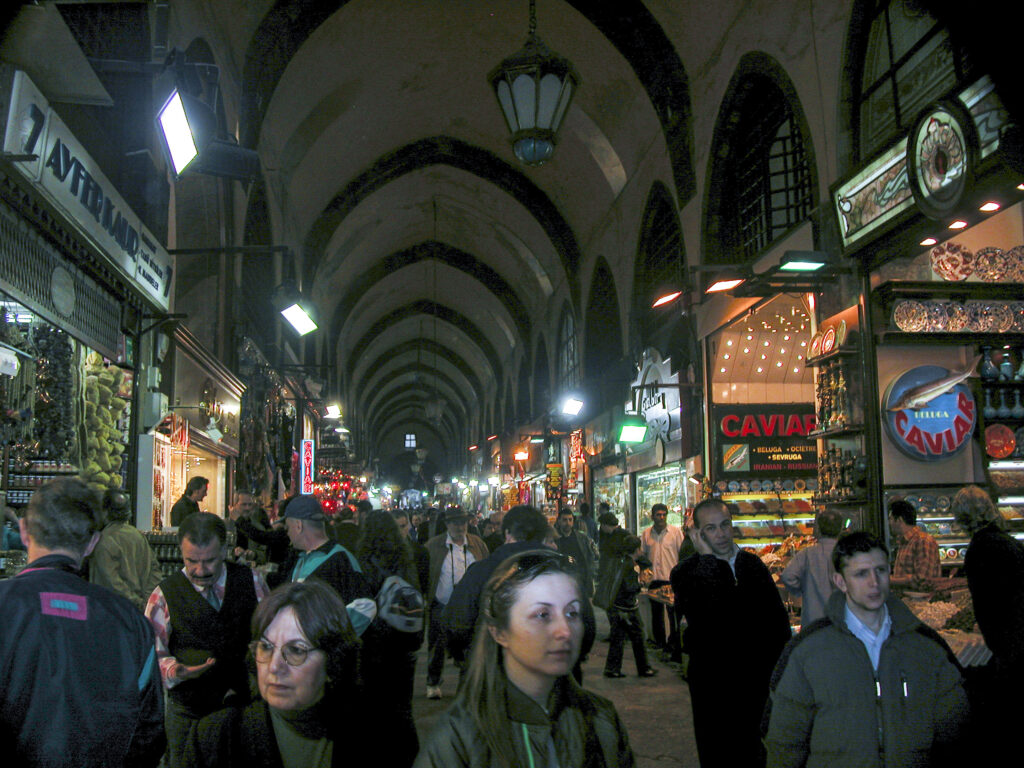
Laden down with goodies from the Spice Bazaar, we boarded the bus to creep our way through traffic back across the Golden Horn to our hotel in Beyoğlu. Rush-hour traffic in Istanbul is not for the fainthearted. I often see claims to the effect that LA traffic is “the world’s worst.” This is nonsense. There are many cities in the world where traffic is worse than Los Angeles, and Istanbul is definitely one of them.
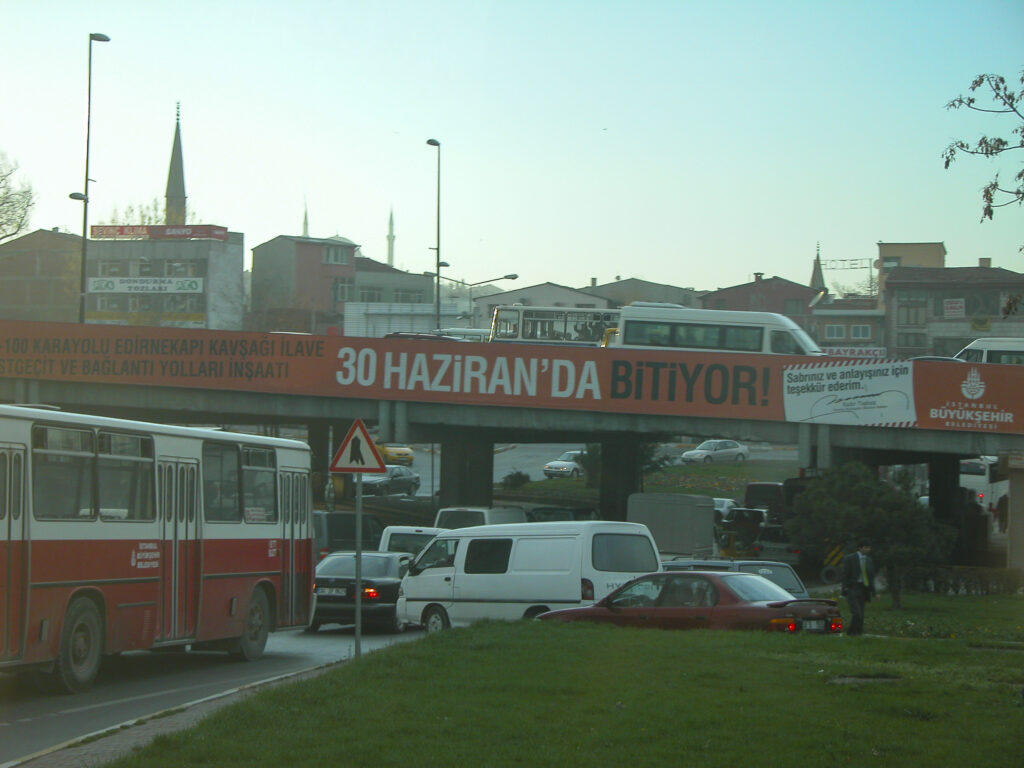
Our guide, Attila, told us that it took him two hours to get from his residence on the Asian side of Istanbul to the European side by car; he used public transportation instead – it was faster.
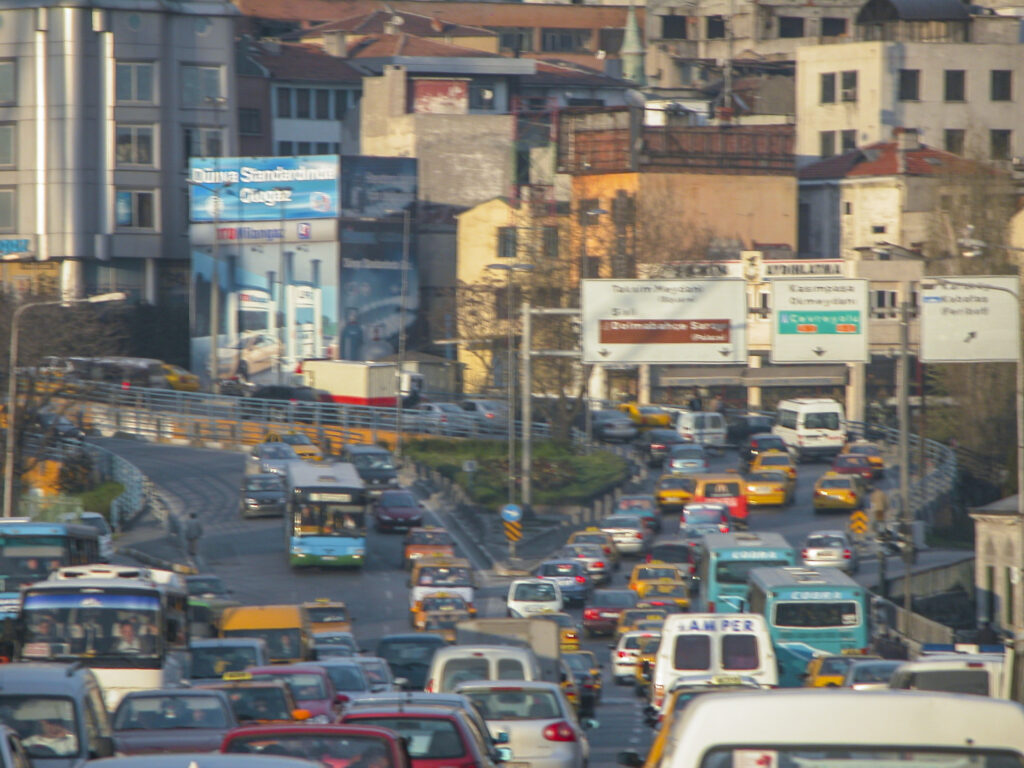
Since the Hotel Richmond was located on Istiklal Street, which was closed to vehicular traffic, we had to disembark from our bus on a neighboring street and walk back to the hotel, carrying whatever loot we had managed to pick up in our forays around the city.
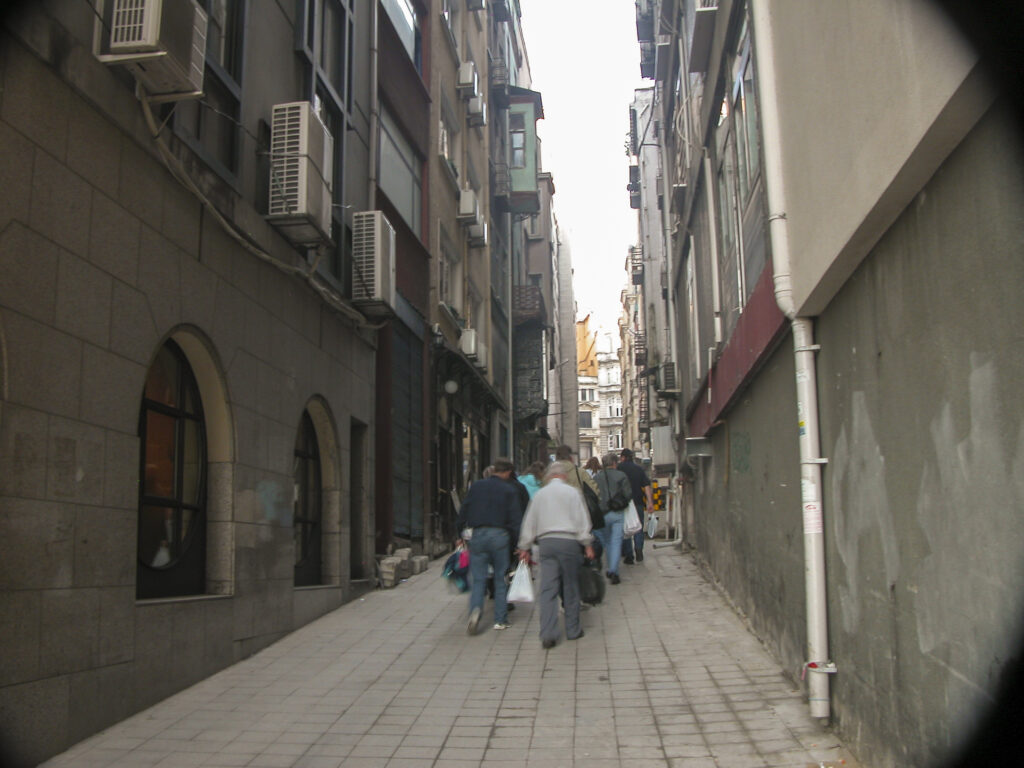
That evening, our penultimate night in Istanbul, those of us who were still able walk and stay upright concluded our exhausting but uplifting day by enjoying a delectable dinner in a fine seafood restaurant in Beyoğlu.
